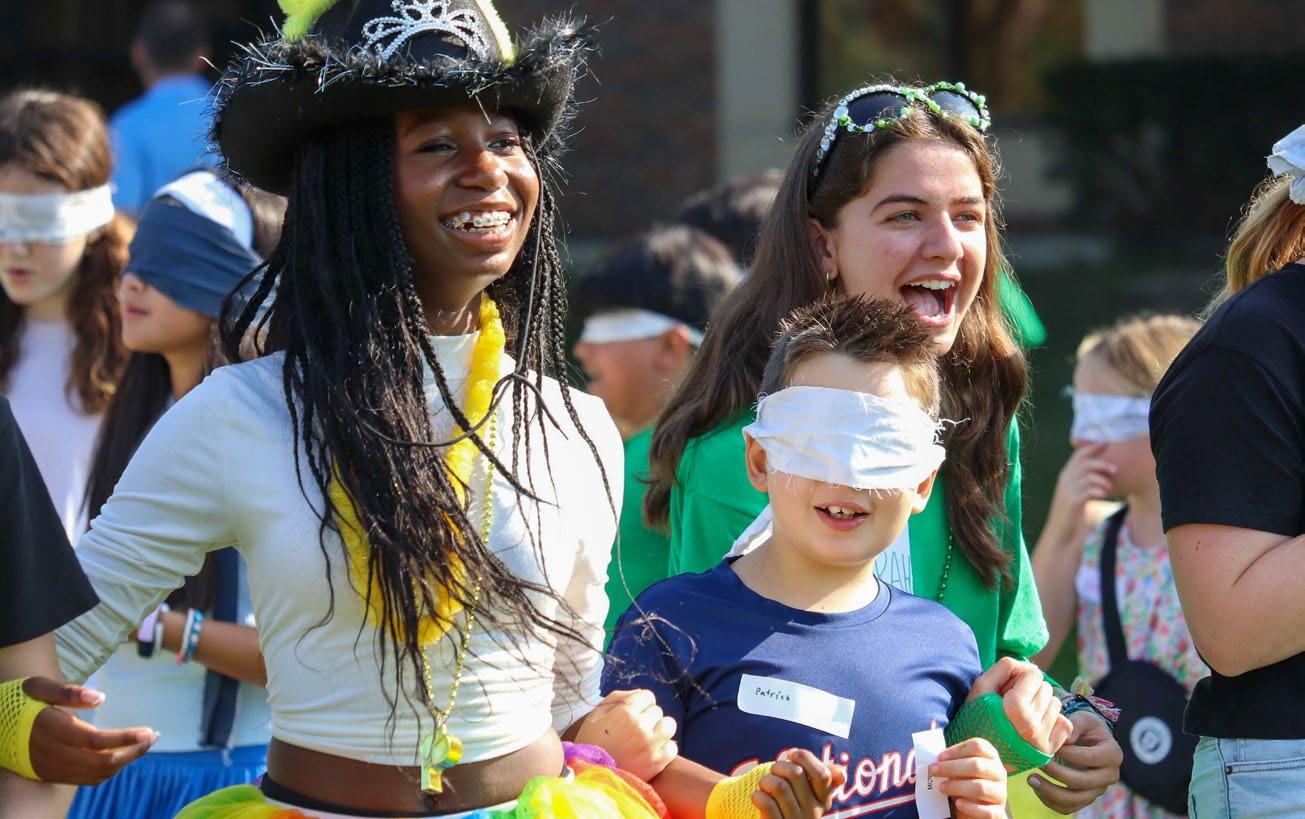ASHBURY NEWS




TO THE 145 GRADUATES OF ASHBURY COLLEGE’S 134TH CLASS!
Your hard work, resilience, and spirit have brought you to this proud moment, and we celebrate all that you’ve achieved. As you prepare to join leading universities around the world this fall, know that you carry with you the values and legacy of Ashbury.
We are honoured to call you Ashburians and excited to see the impact you will make. Here’s to your future successes and the remarkable contributions you will bring to our capital region, our country, and the world.
Well done, Class of 2025!
Celebrating all graduation years ending in ’5 or ’0
• Homecoming Run
• Senior Boys’ Football Match
• Alumni vs. Student Games
• BBQ Lunch
• All Alumni Reception
alumni@ashbury.ca ashbury.ca/homecoming EVENTS



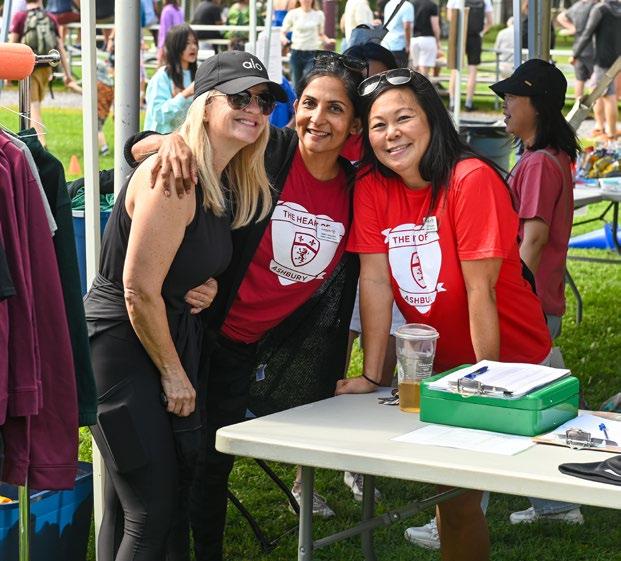
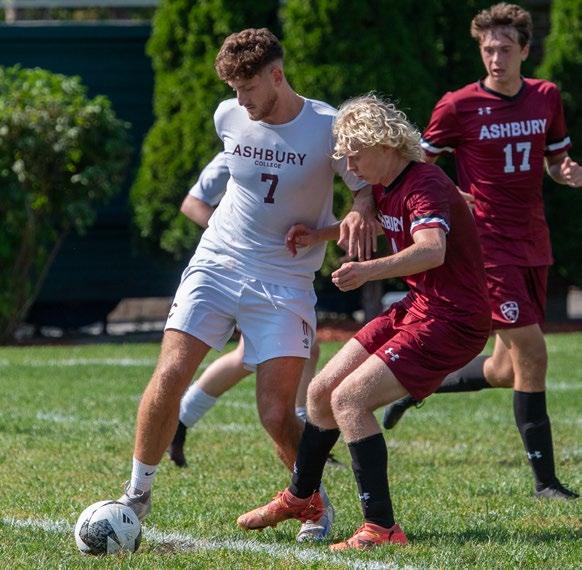

Over 80% of our referrals come from our students, parents, and alumni. Help spread the word about the world-class education available at Ashbury.


Ashbury News Spring Summer 2025
Ashbury News is published twice a year and sent to over 4,000 alumni, parents, and friends worldwide. Submit news or story ideas to alumni@ashbury.ca.
Photography by: Wendy Hough, Chris Miedema, Justin Routhier, and Fuad Saneen
Facebook:

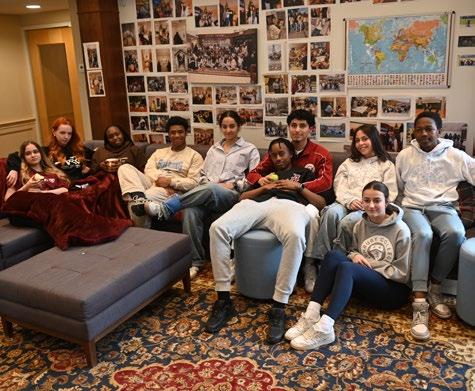






Ashbury College acknowledges that its campus is located on the traditional, unceded territory of the Anishinàbe Omàmìwininì Algonquin Nation, whose presence here dates back to time immemorial.
Nous reconnaissons les membres de la Nation Algonquine Anishinàbe Omàmìwininì comme gardiens et défenseurs traditionnels du bassin hydrographique de la rivière des Outaouais et de ses affluents. Nous rendons hommage à leur longue tradition et à leur constante protection de cette terre, ainsi qu’à leur rôle dans la sauvegarde de ce beau territoire.
Nigìkenindànànàn kìbi ànimiziwàdj kaye kì mino pagidinigewàdj ogog kakina Màyàmindji Nitam Pemàdizidjig, Àbitawizìg, kaye Àshkìmeg eyediwehì enigokwàg iyo Mikinàk Minitig. Niga pàjigwàdizimin kidji kikenindamokìyàng kàbi Awakàzodjig ogog kà abidjig kikinàmàdinànikàng, ashidj niga mino wìdjikiwemànànig ogog Màyàmindji Nitam Pemàdizidjig ondaje wàkàhì.


Entering our 135th academic year in 2025, the horizons for Ashbury remain full of promise as Canada’s international school in the nation’s capital. Our unique blend of students, who are day or boarding, diplomatic, international, and from neighbourhoods around the Ottawa-Gatineau region, makes Ashbury a truly pluralistic community. There are few schools that offer a boarding program that has sustained such success, offering a door to educational opportunities in Canada, a continuity for students whose families may be between international postings or simply a home away from home—une deuxième maison.
Boarding at Ashbury benefits from a close and supportive community, and our day students establish lifelong friendships that circumnavigate the globe. Alumni often note how boarding has evolved over the years, from dormitories in the main building to perimeter campus housing, to the three outstanding residences of today: Gillin, Matthews, and Maple. Boarding in Grades 9-12 remains an integral part of the Ashbury experience and has helped generations of students prepare for university and beyond. As Canada’s international school in the nation’s capital, we remain committed to fostering a welcoming and supportive boarding community anchored in a sense of belonging and academic achievement within our unique location and context.
I look forward to hearing more from our alumni on how boarding has helped you navigate the future and the connections that remain with you.
Probitas, Virtus, Comitas, Norman Southward Head of School — Directeur


Much of the historical information in this article is sourced from A Character of Its Own: Ashbury College 1891-1991, written by Tony German in 1991. This richly detailed narrative traces the path to the present-day Ashbury and was written to mark the school’s centenary. Tony German served as Ashbury’s first Director of Development from 1972 to 1978. Page numbers throughout this article refer to this source.

lmost from its inception, Ashbury College has been home to boarding students. The school was the idea of George P. Woollcombe, a young Oxford grad who had begun his career at Bishop’s College School in Lennoxville, QC (BCS) and Trinity College in Port Hope, ON. In 1891, Woollcombe was recommended by the head of BCS and some Ottawa-based businessmen to start a school in Ottawa. In its first iteration, Mr. Woollcombe’s School was a single-room day school for boys between the ages of eight and fourteen located in the Victoria Chambers on Wellington Street. However, from the outset, Woollcombe intended to create a permanent and much larger boarding school (The Dominion Illustrated, 1891, p.93).
The school catered to the business elite of Ottawa. It quickly outgrew its quarters and, in 1894, moved just down the street to 186 Wellington. At this point, Woollcombe “advertised for ‘resident and day boys and called the school ‘Ashbury House’ after his home in the UK (p.13). By this time, there were 47 students, and expansion was again on Woollcombe’s mind.
In June 1900, with the financial backing of some influential turn-of-the-century Canadians, Ashbury College Company Limited was incorporated to run a day and boarding school for boys and girls. Although Woollcombe never articulated the intention to enrol girls in his school, a provision was in place. They moved to new quarters on Argyle Street, which was equipped with steam heat and electric light and became home to 45 day boys and 13 boarders (p.17). Fees for a day boy at Ashbury were $72 per year and for a
boarder, $316. Extra fees of $4 were paid for extracurricular activities such as sports or calisthenics. By 1907, the school was again bursting at the seams, and plans began for a “proper country location” for a new school (p. 21).
In the fall of 1910, Ashbury College moved to its present Rockcliffe Park location, and by January of 1911, there were 67 day students and 48 boarders.


The main building housed classrooms, a dining hall, and student living quarters, while the west wing was home to Headmaster Woollcombe’s family. The Chapel and Rhodes Hall classroom were added in 1912 (p.23). By 1914, boarders’ fees were up to $500 per year (laundry included!), plus an $8 sports fee. Woollcombe desired Ashbury to become solely a boarding school, but the local families who had built the school insisted that the day students remain part of the Ashbury community (p.30).
The school atmosphere was discipline-oriented, with the expectation that students would be raised as gentlemen. Students received pocket money—50 cents per week for seniors and 25 cents for the younger boys— which students would spend on cigarettes (smoking was not permitted on campus), treats such as ice cream and pie, or outings to the movies or sports events. In 1924, the Memorial Wing, including a gymnasium with rooms above for 10 boys and four masters, allowed for program and enrolment expansion. A new house for the Headmaster was also built at this time, which allowed the conversion of the west wing annex to be used for boarding.
The Wall Street crash of 1929 and the Great Depression brought years of reduced enrolment and financial difficulties to Ashbury, with the prosperous families that
“The school atmosphere was discipline-oriented, with the expectation that students would be raised as gentlemen.”

had filled classroom seats seeing their fortunes blown away overnight. This, combined with the retirement of G.P. Woollcombe in 1933, marked the start of a period of uncertainty for Ashbury with fewer than 100 students and only 55 boarders—20 empty beds made for difficult times (p.74–75).
The solution to these difficult times came with the arrival of 50 new boarders from an English prep school called Abinger Hill in the summer of 1940. The children were evacuated from wartime Britain at a time when Ashbury could not have needed them more. This was also a perfect opportunity for Canadians to help Britain in the war effort. Between fundraising by the Ashbury Board to support the children and money from the Abinger Hill Council, Ashbury was able to take the children in. The Abinger Hill boys integrated well into Ashbury and added tremendously to the life of the school. By the summer of 1944, all the Abinger Hill boys had returned home, and by then, Canadian enrollment was back to its earlier levels with 123 students (p.110–112).
The 1950s saw additional expansion, with the Argyle Wing. However, fundraising efforts fell short, and to meet the shortfall, Head Ron Perry increased enrolment, which led to cramped conditions both in boarding and in the classroom. This push included junior boarders as young as Grade 1 (p.135–136). The juniors were housed over the gym; all other boarders were housed in second-
floor boarding flats in the main building and the west wing. Although Ashbury’s youngest boarders were not a longstanding fixture, junior boarding in Grades 5 through 8 continued until the 1990s.
During the late 1950s and 1960s, Ashbury faced stiff competition from a rapidly evolving public education system. Known for its strict discipline, Ashbury often supported challenging students without the necessary specialists to address them. However, Ashbury distinguished itself through the “polish that a private school imparts to an individual” and its robust athletic training and compulsory sports programs (p.142).
By the late 1960s, the school shifted its focus towards academic excellence, targeting “young people who had problems that understanding, personal supervision, and firm guidance could help” (p. 182). The school’s growth also hinged on the availability of scholarships and bursaries, leading to the establishment of the Ashbury College Endowment Fund.
The 1970s brought significant social changes that charted the course for the Ashbury of today. Tension and turmoil gave way to communication and understanding, and ultimately, a more humanistic approach to students while upholding the fundamental, structured, and disciplined approach for which Ashbury had become known. Not at all coincidentally, this time was marked by equally significant transitions
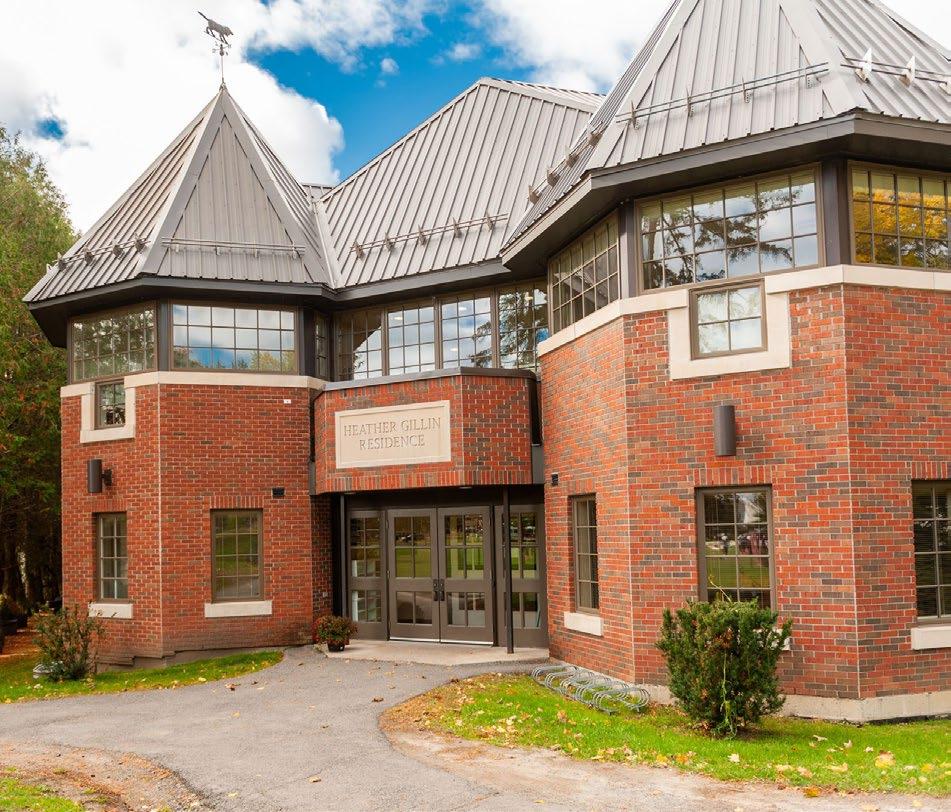
of the physical space of the campus, bringing facilities up-to-date and paving the way for the future of Ashbury. Attendance increased from 370 in 1978 to more than 400 in 1981, including more than 100 boarders; senior boarding fees also increased from $4,100 in 1975 to $6,800 in 1980.
That decade also saw a change in the composition of the boarding population—it was becoming more international, with students from South America and Hong Kong and a growing diplomatic presence in Ottawa. The school was also becoming invaluable as a stable educational setting for federal government and industry families that found themselves being posted overseas. During this time, the demand for boarding remained constant, while the demand for day positions grew due to turmoil in the public education system across the province (p.195–197). The strength of applicants both day and boarding also improved due, in large part, to the 1974 decision to offer the IB Diploma Programme (p.214).
Other changes were happening during this time: the first presence of girls on the Ashbury campus was in 1967, with the cross-pollination of Elmwood students taking classes at Ashbury and vice versa. The program of shared courses grew through the 1970s and allowed for more credit options for students at both schools (p.198).

In 1982, Ashbury opened admission to Grade 12 and 13 day girls who wanted to pursue the IB Programme. That fall, Ashbury opened its doors with 434 students, 13 of them girls. The following year, Grade 11 girls joined Ashbury, raising the number of female students to 28. This cohort included nine female boarding students (p. 219). The female students were placed in the main building annex and perimeter housing, living with Ashbury teachers and their families in schoolowned homes around the campus. This perimeter housing increased capacity by approximately 25 students. Meanwhile, the boys stayed in the boarding flats in the main building. By the fall of 1990, Grade 9 and 10 girls were welcome at Ashbury, bringing the number of girls in the Senior School to 120 out of 360 students. It would be
“For many of our international students, Ashbury is a family’s first step into Canada.”

twenty years before coeducation was introduced in the Junior School in 2010.
In its “Towards the Year 2000” planning document, the projections were for a school ceiling of 520 students—340 would be in the Senior School, and about a third would be girls. Junior School boarding was declining and would be phased out with a target of 100 Senior School boarders, half boys and half girls (p.246).
The past quarter century has seen continued expansion in infrastructure and student numbers. Teaching and learning spaces such as the Benloulou Gymnasium, the Creative Learning Centre, and the Centre for Science and Innovation have changed the Ashbury experience for all students. However, perhaps the greatest change in the Ashbury experience has come for our boarding students, who now benefit from significant investments in boarding facilities. In 2007, the Heather Gillin Boarding House for girls was opened. That space was later expanded to provide homes for 53 female students. Two years later, Matthews Boarding House for boys was opened and currently houses 51 male students. Reflecting the popularity of the boarding program for our female students, Maple Boarding House was opened in 2016, housing seven more girls. Unlike the tight and minimalist quarters of the past, Ashbury’s three state-of-the-art dormitories are equipped with common areas, laundry facilities, spacious kitchens, games and study rooms, secure high-speed internet, weight training
and fitness areas, and feature a mix of single and shared rooms with en-suite bathrooms.
Today, our boarding program offers a rich intercultural experience for our students that indelibly impacts the school’s character. With more than 60 countries represented on campus and our commitment to cultural pluralism, Ashbury is producing “global citizens” with curiosity and respect for people from different cultural backgrounds. For many of our international students, Ashbury is a family’s first step into Canada—the student comes to Ashbury and moves on to a Canadian university and then finds employment here before bringing their extended family to join them. There is now an extensive Long Weekend Program for boarders unable to return home during breaks that gives students a glimpse of Canadian culture in and around the nation’s capital and on trips to nearby locations such as Montreal, Montebello, or Mont Tremblant.
The expansion of the suburbs of Ottawa over the past two decades has also created the desire for local families to place their children in boarding on a Monday to Friday basis. This allows children to participate more fully in extracurricular activities and spend time otherwise needed for commuting more wisely, focused on their studies. As a final point of comparison, today, Ashbury has 750 students, 111 of whom are boarders. The gender split is approximately 50:50.
Ashbury College has evolved significantly since its founding, adapting to changing times and needs while maintaining its core values. The boarding program has played a crucial role in shaping the school’s character, offering students a home away from home and fostering a sense of global citizenship. As Ashbury continues to grow and innovate, it remains committed to providing a nurturing and enriching environment for all its students, preparing them for success in an increasingly interconnected world.
In Grade 8, Andrew Nichols lived in west end Ottawa, commuting daily to the school. When his family decided to move back to the Toronto area, they started looking at school options there. “I just kept coming up with different reasons to justify why those options wouldn’t be great…Maybe I was trying to plant a little seed of doubt. My dad eventually asked, ‘Would you be interested in staying at Ashbury in boarding?’ I thought, absolutely!”
“I think the reasons why I wanted to do it and what I got out of it are probably quite different. I wanted to demonstrate that I could manage on my own with that level of independence. But some of the greatest lessons I learned were tolerance, understanding, and flexibility. When you go into boarding, it’s a new routine; you have a roommate who’s not a sibling, and you’re eating meals, family style, all the time. You need to become very tolerant and develop a much higher degree of flexibility. When you go to university, that’s exactly the shoe that needs to fit. Boarding was a great opportunity for people to become a little bit more independent and develop some of those tolerances in a safe way. When you go to university and you’re in residence, nobody

cares if you get up for class or if you eat! Boarding was a great bridge to a bigger, independent life.”
Andrew recalled his living space at Ashbury. “I was in the hallway in the main building, right above the main hallway on the third floor.” He joked that, “the room I had in grade 13 has now been split into two different rooms, and they are storage closets. Our room had no window. It had a skylight, and that was more than enough for us. That was 1991.”
“Athletics were a big part of who I was when I was at Ashbury. When I was a day student, I lived in Kanata. It could be quite late, easily 5:30 or 6:00 p.m., when athletics finished, and I would have to take the bus home. One of the big things boarding afforded me was that I could really take in all the opportunities the school had to offer without having to worry about how I was going to get home, and I was there if I needed to get to school a little bit earlier for some extra help with a particular subject. It wasn’t
a huge burden if I needed to stay late or get some help in the evenings. I have such vivid memories of prep finishing and racing down to go play basketball, and we would order a pizza at 9:30 p.m. I have all of these wonderful lasting memories about my time at Ashbury—I just would never have been able to partake had I been a day student. You get to know your friends at a deeper level. That’s not to say that I didn’t have wonderful friendships with other day students, but the boarders, we were in it together.” And Andrew did thrive at Ashbury; he was Captain of the school in 1990–91, a multisport athlete and quarterback of the football team, as well as an award-winning student.
Andrew spoke of the selfsufficiency he developed during his boarding years. “You just had to figure it out on your own; whether it was laundry, health, or getting your own toiletries, you just figured it out. I had always thought that even one year or preferably two years of boarding would be a great bridge to help people be better prepared for the demands of independence when they went to university. And as an athlete, sometimes if you are in boarding, you have better opportunities to really focus on your sport. For your first year, you’re trying to learn the ropes, you’re figuring your way, and by your second year, you’re really maximizing it. The
reality is, it’s becoming so much more competitive to get into universities both domestically and abroad, that if you can squeeze every ounce of benefit out of being on campus with access to everything and everyone, it is going to be absolutely invaluable.”
These reflections led to the creation of the Michael Dwyer ’20 Memorial Bursary. Established by Andrew’s father, Anthony (Tony), in collaboration with Andrew, the bursary honours Anthony’s uncle, Michael Dwyer, who attended Ashbury College in the early 20th century. Uncle Michael bequeathed some funds to the family which were used in 2008 to establish a bursary founded to endure in perpetuity, with its funds invested in the Ashbury College endowment. The bursary is intended to provide a day student with the opportunity to experience boarding (usually for their graduating year) to eliminate commuting or scheduling limitations. The Michael Dwyer ‘20 Memorial Bursary has empowered its recipients to fully engage in student leadership opportunities, co-curricular programs, academics, athletics, the arts, and the many friendships formed in the boarding community. It is truly a transformational opportunity. Former recipients of the bursary continue to inspire and impress in their postAshbury pursuits, from Harvard graduates to young pre-med students and investment bankers on Bay Street. The Michael Dwyer ‘20 Memorial Bursary has played a significant role in
their development and success. “We are very proud to have participated in helping them get that experience and setting them off on that track.”
No conversation about Ashbury boarding is complete without reference to the international experience it provides. “It goes without saying that Ashbury is an international school. You’ve got day and boarding students who come from various countries around the world, whether their parents have been stationed in Ottawa or not. I learned so much about other cultures that I would not otherwise have been exposed to. As a point of reference, the two children of the Iraqi Ambassador were in Ashbury boarding at the start of the first Gulf War. Imagine those conversations and understanding those nuances. I have maintained a great friendship with a student from Trinidad, and I have had many occasions to visit him in Trinidad and experience that culture. That is something I would have never been given the opportunity to do.”
“I think the Ashbury advantage is that you get unbelievable opportunities to mix international points of view with the heart of Canada’s political system. And when you mix those two things together, you will come away far more aware of challenges on the horizon, both at home and abroad, and with an understanding of where you can play a role. I feel, by being at Ashbury, at least when I was there, you tended to be less inwardly focused and more openly outwardly
focused.” Adding to this setting are the teachers. “Round Square didn’t exist, but Alyssa Novick’s early efforts to bring broad cultural awareness started back in the 90s. The types of teachers that you have access to are really special, and if you can take advantage of it and recognize it, you will benefit. These are selfless people who have chosen to do work that is for the greater good—educating kids and getting them ready for the next steps. These teachers challenge you to think in untraditional ways. When I was in public school, I was always the kid who would ask, ‘Why do I need to learn this?’ The answer would always be, ‘because.’ It wasn’t until I went to Ashbury that it was explained to me. Even if I didn’t agree, it helped me see the connections to other parts of my life.”
...some of the greatest lessons I learned were tolerance, understanding, and flexibility...
We are fortunate that Andrew decided to stay at Ashbury—beyond his family’s generosity through the Michael Dwyer ’20 Memorial Bursary, he has gone on to volunteer and support many Ashbury initiatives as a Governor, committee member, class representative, reunion representative, and champion.
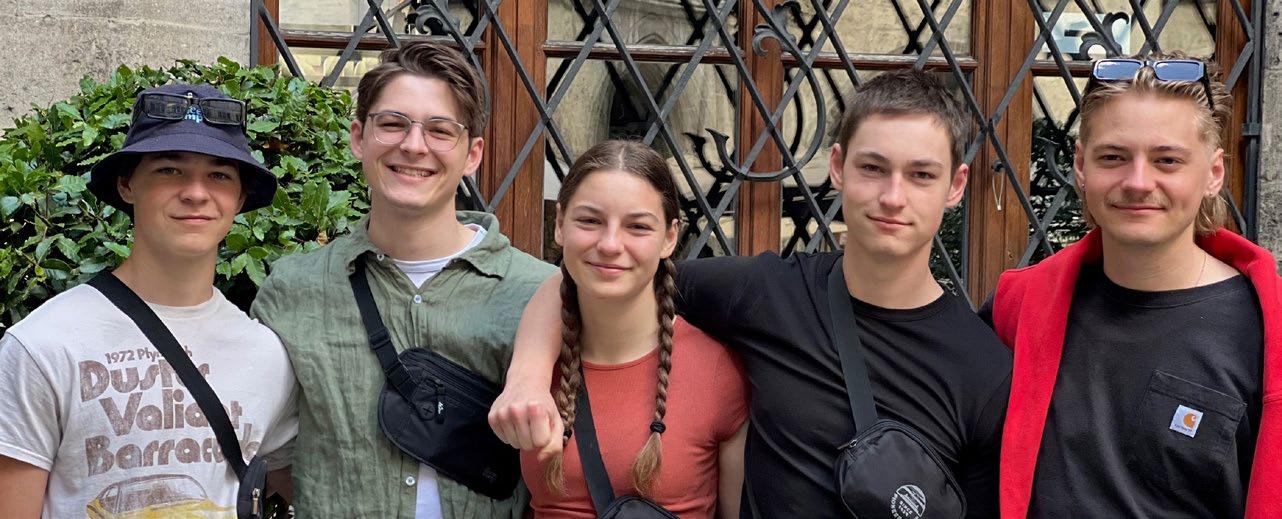
The Gauthier family is a true boarding success story that came about quite by happenstance. Ashbury News caught up with five of the seven Gauthier clan members to discuss their family experience in Ashbury boarding.
According to mom, Stephanie Gauthier, the decision to send their children to board at Ashbury was like “a cosmic alignment. It all happened in this cascade of events that wasn’t planned or organized. I grew up all over the place because my dad did diplomatic and economic development work. I really wanted my kids to have roots, so we planned to settle down somewhere the kids could go to the local school. It didn’t work out that way. They ended up going to the French school in the town next door, and Chris came back to school here (in Perth, Ontario); Chris was doing really well—everybody loved him, and he was doing zero work and getting fantastic marks. He brought home an assignment, and it was terrible. I thought, this cannot continue. This is a set-up for failure in life.
It just so happened that we had both taken some time off to work on the house. When I started to look into schools in this region of Ontario, Ashbury was right there. Coincidentally, we had to go to Ottawa to buy some supplies, so we went to look at Ashbury while we were there. When we arrived for a tour, Padme (Raina) showed us around. She walked us through Matthews house and told us lots of stories, and by the time we were done, I thought, OK, I could actually see myself sending my child to boarding and not just to a private day school. There was something about her that made me believe that Ashbury would really look after my individual children beyond just the academics. I think the school really followed through on that promise.”
The Gauthiers’ oldest child, Christophe (Chris) ’18, was invited to come up for a day visit. When he returned from his visit, he said to his mom with surprise and enthusiasm, “Mom, the classes are quiet and people have discussions with the teacher, and nobody’s yelling. It’s like people are paying attention.” When Stephanie asked him if he liked that, she got a resounding yes. Fortuitously, a spot had
opened in boarding in February to add to the stars aligning. Chris’s acceptance caused great family excitement, son Nicholas recalled. They received the news while on a family vacation in New York. Nic said, “When Chris got accepted, you guys were ecstatic!”
And so started one family’s story!
“Chris was thriving; they had taken such good care of him. Mr. Lamont was head of Boarding then and was so good at pushing him where he wasn’t reaching his potential. He also recognized that Chris was lonely for his family, so he asked Chris to babysit to give him a little bit of family life.” Chris and Mr. Lamont are still in touch today.
“Chris had so successfully integrated into Ashbury, so we thought it would be amazing for Nicolas (Nic) ’20 and Phillipe (Phil) ’20 to go. Nic needed academic challenges—a place where smart would thrive.” Father, Alain added, “Where smart would not get irritated, and so Ashbury was perfect for that. When asked what about learning at Ashbury kept his attention, Nic replied, “I think being able to engage with the teachers was really fun. Even at Ashbury. I was one of the more engaged students, or someone who was really into the work, maybe too much, but the teachers would feed off that. It was nice knowing that if I wanted to accelerate my pace, the teachers could accommodate that. Some teachers that come to mind are Miss Mitchell, who taught math; Miss Usmani, who taught business; and Miss Lu, who taught science.
They were all so personable and got to know your skills, which I think was the key to thriving.”
Reflecting on what their experience would have been had they been day versus boarding students, Nic spoke of the convenience. “I woke up at 7:45 every morning, and it was fine to make it to class. Dinner is there. Lunch is there. Your friends are there. When we went to elementary school, all the friends we went to school with lived in the town over, which was up to a 30-minute drive away. So, we didn’t get to see them on weekends or after school. That was facilitated in boarding, to be able just to see everyone all the time. I think that was conducive to learning, to live in an environment with a lot of people; it has helped me so much in having roommates as an almost adult.”
“ ” ...we wanted them to see how big and how amazing the world was with different cultures...
The youngest Gauthier, Catherine (Cat) ’26, joined us from her room in Gillin and graciously gave us a walking tour of her room! We asked Cat what it feels like to be at the tail end of a family legacy here at the school, and how she has been compared with her brothers. For context, Chris was Arts Prefect, Nic was Woollcombe Captain, and Matt was Boarding Captain. In response to that, Alain chimed in to say, “Ask her what her new position
will be next year.” Cat replied, “School Co-Captain.” She recounted that, especially in Grade 9, she was known as the last Gauthier kid. “It was not an identity I had to shake, but a position I had to grow from. I think it helped that we had different paths at the school and that I was the only girl. In many ways, it was great being known as part of the family, as teachers like the Gauthiers most of the time!” Stephanie offered more props to Mr. Lamont for helping nurture her children’s leadership skills and helping “Cat gain the confidence she needed to aim for School Captain.”
Stephanie also spoke about the experiences of her two other children, who could not join us in our conversation. “I also want to give a huge shoutout to Mr. Brian Storosko, who was a huge supporter of Phil. He really took the time to see past some of the dumb stuff Phil did and worked with him to become a better version of himself. He was so kind and so good at understanding the different ways that kids think. Mr. Storosko also looked out for Matthieu (Matt) ’23.”
When asked to share their thoughts on what the “Ashbury advantage” is and whether boarding adds to that, the Gauthiers had much to share. Chris said, “For myself, the largest thing I got out of it, outside the academics, was the push to do co-curriculars, to do things you’re interested in, and to expand in those areas…the obligation to try was huge; it definitely planted the seeds of things that are happening in my
life now as I continue to follow my aspirations and to seek for more than just a simple path. In boarding, that sentiment was extended—the push to try new things.”
He also spoke of the influence of the internationalism of boarding at Ashbury. “We’re from a small town where there’s not a lot of diversity. So, coming to Ashbury was eyeopening in the best way, and I think it’s what’s drawn most of us to the city now—we’re all in Toronto except for Matt, who is currently overseas. We’re all very attracted to different cultures, learning about them, and travelling. Ashbury was the starting point for that.”
Stephanie added, “That was one of our goals in sending our kids to Ashbury; we wanted them to see how big and how amazing the world was with different cultures, different ways of living, different faiths, different histories.
Cat echoed Chris’s sentiment about the Ashbury advantage. “Everyone wants to succeed in their own way, and it pushes you. All my friends are super driven, and driven in different ways, pushing me to succeed in my own right.” She also spoke about how Ashbury contrasted with her previous educational experiences.
“I remember feeling flabbergasted that people were happy to be at Ashbury. There were people wanting to learn, teachers wanting you to succeed, coaches wanting you to be good at sports, and people wanting to be your friend. It makes you want to be more
involved, to be better at academics, to be better in your sport and your clubs. In boarding, the desire and the drive to be a part of Ashbury life is really strong because you’re here, and you have to be here, and your life is school life. And because of that, everyone wants to push themselves in some way.”
Nic’s perspective on the Ashbury advantage was, “that you could be unapologetically yourself. There was always an environment in which you could explore a new aspect of what you wanted to be. I’ve always been someone who has done things on my own, and there was a place for that at Ashbury, which made it feel like home. In classes, I could do things on my own, and I could choose the co-cur-
riculars that I wanted to—there are so many options that you can choose. The flip side is that the teachers would also encourage you to choose things beyond your comfort zone. Boarding helps you get out of your comfort zone—living so closely with people, new people, people from all around the world. It was such a great environment that it felt like home and was also an adventure at the same time. I could not have gotten that as a day student.” Cat added, “The thing about boarding is that it forces you to be close in the most amazing way.”
When asked if Ashbury and boarding would be in their children’s futures, Nic jumped in and couldn’t help but tease his mom. “Absolutely, or
an experience somewhat like Ashbury. I think the autonomy we gained from being abandoned by our parents at 14 (that’s a joke, Mom) has been wonderful, especially the transition from high school to university. That transition is awful for so many moving straight from home, but for us it was absolutely seamless.”
Although Cat remarked that making friends at first was the hardest thing for her about being in boarding at Ashbury, because she is an introvert, she, Chris and Nic all said that the most valuable thing they got and what they will take with them throughout their lives is the friendships they made here. Perhaps that is the true essence of the Ashbury advantage.
ARE YOU CURIOUS ABOUT THE BOARDING SCHOOL EXPERIENCE?
Ashbury Overnights offers a unique trial program designed to immerse students in the vibrant boarding lifestyle. From engaging academics and enriching co-curricular activities to the daily routines and communal living, this program is your gateway to understanding the essence of boarding life.
WHO CAN PARTICIPATE?
• Day students eager to experience boarding first-hand
• Prospective boarding students looking to explore Ashbury
• Short-term stays for our diplomatic and day community

Join us for Ashbury Overnights and discover if the boarding environment is the perfect fit for you and your family.
For more information about boarding or Ashbury Overnights, contact Nicole Hynes, Director of Admissions at nicole.hynes@ashbury.ca.

Jane Kennedy was pivotal in the integration of the first girls at Ashbury. She came in 1973 to teach business, economics, and keyboarding. Nearly a decade later, enrollment opened to female students, and Jane was chosen to lead the shift to co-education as the Dean of Women. “When Tony Macoun called me in to ask if I would be interested in working with him to set this up, I was delighted because I felt the girls would add so much. I had great support from the staff, particularly in boarding, including Hugh Penton, Ray Anderson, Jim Humphries, Bob Zettel, Ross Varley, and Peter MacFarlane.”
Jane says her main role as Dean of Women had two distinct parts— discipline and guidance. “It was a very hard line to walk. You wanted to get close to the students and know they were all right, especially the international students and the kids from
away. You wanted them to know if they needed you, you were there. I would tell them that if they got into trouble, I was their first call. I don’t care what hour it is; I will pick you up. And I did go pick kids up at various spots when they got in trouble. But then it was difficult because you would have all that information when you got called into the discipline team. You would have to meet as one of three and a Headmaster. And sometimes things would not go, as the kids would say, in a just way. Sometimes, the kids would be disappointed with the decisions that were made, but I was one of three or four people, and I couldn’t always get my way. I was forceful, but when it is explained to you that this is the rule and this is the custom at the school, and this would happen if it were a male student in this situation, there was really nothing more to do. But it was hard to be involved with students as a parent figure for both support and discipline. It was walking a careful line between the customs, the rules of the school, the parents’ expectations, and the Headmaster’s expectations.”
Jane had her own unique brand of discipline for her charges. “I could put a child in a classroom in detention on a Saturday for four hours sitting at a desk, or I could get up at 6:00 a.m. and walk with them down to the market in Ottawa, even in the rain. I walked, they walked, and when we got back, we would have breakfast together in the dining hall—I got to talk to them, and they weren’t cross after. The kids would say, ‘don’t get her
angry, cuz she’ll get you up at 6:00!”
When asked what she thought was the best thing to come out of having girls boarding at Ashbury, Jane replied, “I think it pushed the boys from an educational standpoint; I’m not saying every boy, but the majority stood up and took notice, and it pushed them a little further. Of course, it pushed the girls, too, because they wanted to make their mark. The boys even started to tidy up their uniforms!”
Jane was at the school until 2004. During her decades here, the physical arrangements for boarding changed greatly. In the early days, 11 or 12 girls were housed in the space right off the main office in the house where the Assistant Headmaster lived (the west end of the main school building). Jane spoke of the girls’ main room, called The Aquarium, as one of the girls had painted a mural depicting fish and turtles. “It’s funny what you remember!”
The girls eventually moved into some perimeter housing with staff members, such as Ray Anderson, Michelle and Ross Holman, Jim Humphreys, Hugh Robertson, and Ross and Mary Ann Varley.
“
” ...you have to be kind, receptive to each other, and understanding...
Thinking about the advantages students gain from boarding at Ashbury, Jane spoke of “the sense of international community and understanding…I think the students
learn from each other so naturally in that setting.” But not all the advantages are as straightforward or obvious: “Friday is the loneliest night of the week for boarders. Many boarders would leave for the weekend; some would stay with friends, but others would remain in boarding. I just wanted to make sure they could connect with each other for a movie night or get together and go somewhere. We just had to try to organize things.” That loneliness was the impetus for starting the Friday night skiing program and boarding trips to hockey games. These initiatives have grown into the current model of organized weekend activities and our fun-filled Long Weekend Program, where boarders can go on weekend excursions to places like Mont Tremblant or Montreal.
Jane insists that in telling the boarding story, we include the pivotal
role of the school nurse for the boarders. “The nurses who were there during my years, from Mrs. Hamilton to Sharon MacKay and Tui Noonan, played an important role in the kids’ lives. They were available all hours. They provided health information to the girls, and they were there to chat over different things the girls were dealing with. We, Ross Varley and I, moved heaven and Earth, with a lot of support from Headmaster Roy Napier, to get a full-time counsellor on staff. He saw that it was needed.” Enter Chapman Uko as a great character in the story of Ashbury College. “The kids needed an independent adult they could confide in—and that need was throughout the school, not only for the boarders.”
Jane spoke fondly of the boarding staff, like Patty Carleton, Michelle Holman, and Shelley Gomme, who kept the students active and engaged
Gerry is a true Ashbury Old Boy! He was born in Dublin in 1946 and started school at Ashbury at age 7 in Grade 2, living in boarding until the end of Grade 13. His mother and stepfather moved to Canada from the UK in 1951 to start a ladies’ clothing retail business in Montreal, leaving Gerry’s grandparents, aunts, uncles, and
cousins behind. Gerry describes his childhood as lonely, without siblings or his extended family. His parents were very busy with the demands of their business, so when Ashbury came to their attention, “it was the perfect solution because it was a good school, they could afford it, and I would get a good education…it was only two hours away by train.”
His early days at Ashbury were not easy. Gerry spoke of the mischief that could happen in a room of four
and wholeheartedly welcomed them. Reflecting on that reminded Jane of an occasion when she was asked to speak to Junior School students some years after retirement. “I quoted history and a lot of stuff, but I told them the important message is that you have to be kind, receptive to each other, and understanding. Being kind, smiling, and welcoming can make someone’s day so much better.” What a wonderful take-home message from someone whose career was making Ashbury a home away from home for so many students.
In her retirement, Jane lives in Ingonish Ferry, the northern part of Cape Breton, on the Cabot Trail. She spends much of her time working on her century-old home, which was built by relatives. Jane says she treats the considerable yard work around her house and barn as her gym!

students and a room captain who was only two or three years older than the other boys. The situation was made more difficult by the wellintentioned actions of his Grade 2 teacher, Mrs. Hunter, who thought little Gerry was very special and skipped him a grade. “That didn’t matter when I was young—when I was 7, 8, 9, 10, but
once I got to be 12, 13, 14, 15, it really made a difference. I was so immature for my age and essentially, a year and a half to two years younger than my peers. She meant well, but it had social consequences.” Also, “because I was younger and I was a small child, I was not as strong as the other boys, so I had trouble in sports…I became a real bookworm and receded into books. That was a sort of retreat, an area where I could excel, so I often won academic prizes.”
“ ” The word home is very powerful…over the years, Ashbury did become my home…
Despite these difficulties, Gerry speaks highly of his time living and studying at Ashbury. “I had good relationships with my teachers— there were two or three that I liked the best. Mr. Snelgrove, who was the oldest of the teachers, is the person who gave me a love for science.”
Upon graduating from Ashbury, Gerry went to McGill University to obtain his Bachelor of Science and medical degree.
Greater than the value of his teachers’ impact on his education and career, Gerry speaks with heartfelt gratitude about the community he found within Ashbury’s walls. “Within a couple of years of being at Ashbury, I was comfortable; I was in a place where I had companionship and friendship. My biggest life lesson from
Ashbury was learning to relate to other people with my peers and teachers around me. That human interaction was most important for me because I didn’t have much of it at home.”
Gerry spoke of profound friendships he developed at Ashbury, including his treasured friendship with Adam Podhradsky ’63, a young student from Hungary whose family had narrowly escaped Budapest before the Russian invasion. He shared with us some shenanigans they got up to while in the Cadet Corps at Ashbury. Adam was diagnosed with systemic lupus during his days at Ashbury, which greatly saddened Gerry. Adam Podhradsky, died on December 10, 1963, in his final year at Ashbury.
Like many Ashburians of the day, Gerry spent most of his summers at Camp Kawabi in the Haliburton Highlands, which then-Headmaster Ronald Perry owned. Gerry also fondly recounts his weekends with classmates’ families in their homes. These experiences enhanced the sense of community that Gerry associates with his time at Ashbury.
As playoff madness sweeps Canada this spring, Gerry shared this wonderful memory of his days at Ashbury. “In the spring of 1959, the Leafs were against the Canadiens. It was 3-1 for Montreal in the final series as we gathered in Mr. Sibley’s room to watch the fifth game. The other boys cheered on the Leafs loudly while I yelled for the Canadiens. Truthfully, I was pretty obnoxious and jumped up
and down as Montreal won the game 5-3 while the players hugged each other in victory…Finally, they had had enough and so they grabbed me by the shoulders, led me downstairs and threw me in a shower fully clothed. They turned on the cold water and left me there for what seemed like ages. But I didn’t mind because deep down I was warm and happy as my beloved Montreal Canadiens had just won another Stanley Cup!”
For Gerry Greenstone, the title of this edition of the Ashbury News is very fitting. “The word home is very powerful. It has many connotations, and it’s a word people carry around inside their hearts. And for me, over the years, Ashbury did become my home, not just because I spent so much time there but because of the people and the relationships I developed.”
Gerry Greenstone is now retired and lives in Surrey, British Columbia.

Kaniz Williams ’18 came to Ashbury as an international student from Nigeria in Grade 9 and spent his years here living in Matthews House, overlapping two years with his sister, Kasheefah ’16. “My sister paved the way. My parents knew they wanted us to go to an international school; they always valued global education. They always felt you could learn a lot from a classroom, but you could learn so much more from being in different environments. They know the size of the world and that the best education is through lived experience. Obviously, you have to be quite privileged to do that, and we acknowledge that and are thankful for it now.”
“When I got to Ashbury, it felt like everyone already knew me just because my sister was there. I visited the school every year when we dropped Kasheefah off, so when I got there, it felt like I already knew the place. And all her friends were like, ‘Kasheefah’s brother is here!’ Some of them had siblings in other grades that they introduced me to. In the boys’ residence, people would say, ‘Leave Kaniz alone, that’s Kasheefah’s brother,’ and in the girls’ residence, all the girls would say, ‘Kaniz, do you need anything?’ because I was Kasheefah’s brother. Kasheefah was like a weird saint-angel looking out for me all the time. I was frustrated because I didn’t think I needed the help, but in hindsight, it made Ashbury a lot easier for me.”

When asked about the best part of boarding, Kaniz replied, “access— access to people, access to learning. With 50 other boys, from so many different places, who act so differently, you’re constantly in conversation with someone else about something else from somewhere else that you had no clue about five seconds before! Boys’ rez was really good in that way: it felt like we could sit at any table and be with anyone. It sounds cliché, but we had brothers. Obviously, you weren’t close to everyone. But we knew that everyone there had your best interest in mind. Everyone there would check if you had gone to dinner, and if you hadn’t, you would walk to dinner together. Everyone there would help you avoid getting in trouble. So, it was like a weird brotherhood. It was never forced. Mr. Lamont never came up to you saying, ‘You have to go speak to X’. It was natural and, because of that, genuine. If someone didn’t want to speak to you, they’ll tell you they didn’t want to speak to you and leave. And that was completely fine because you
understood they had stuff to do. Also, you had people who wanted to keep to themselves and the cool thing about it was they were respected, and you allowed them to keep to themselves, and whenever they wanted to chime in, they were allowed to join in.”
Kaniz said that the most difficult part of being in boarding was “understanding that introverts are just going to be introverts. It’s the flip side of the best thing, because when you’re running around and having fun with 40 people, you want to include the other 10, and sometimes you can’t. Another obvious thing about boarding is that it felt like the day students could do whatever they wanted and be fine. In boarding, you always had eyes looking at you. We had Mr. Hall in Grade 9; we used to call him the ninja. If you were ever doing anything wrong, he would randomly be behind you. There was no escaping it. If you left your laundry in the laundry room past curfew and you’re not meant to be out of your room, and you hear him go down the hall to the other side, you think you could just sneak quickly, grab the laundry, and come back to your room? You and your roommate have this elaborate plan. You leave the door open, so you don’t have to beep back in—everything’s perfectly orchestrated. And as soon as you run out, you get to the laundry room, and you turn around, he’s just there. There’s no anger in his voice. It’s just, ‘You shouldn’t be doing this,’ and you walk back with your laundry, thinking, Oh! And you get a demerit.”
Reflecting further on the difference between day and boarding students, Kaniz pointed out that, “boarders were lucky because they had friendships and relationships that transcended grades; for the day students, almost all their friends were within the same grade. But socially, it was a lot easier for the majority of day students than for boarders. They have the houses and access to a car—they have access to different things that we would have been restricted from. That was most apparent on weekends when things got planned; we would get invited, but we had a curfew at 10:00 p.m., so it wouldn’t make sense for us to go. That became very frustrating. You could work around it by signing out to day students’ houses for a sleepover, but it was a tough ask. And then you would have to explain to your parents that you’re sleeping at this random person’s house.“
Kaniz said, ‘It would be criminal for me to pick one thing,” when asked what his most memorable experience in boarding was. “Sometimes it would be lonely on long weekends, when others would get to spend time with family, but they would organize these trips, whether it was to see a Raptors game or hockey. First dibs was always to the boarders, and if there weren’t enough boarders interested, then we could invite the day students to join in. It was like a big road trip, with everyone in the car. It felt like it was cool to be a boarder.”
Another story Kaniz shared was when he became the School Captain
at the end of Grade 11. “When the results were announced, I was on a camping trip with my friends Chris Gauthier, Karl Hunger, Chris Abrahamson, Hugh Graham, and Ali Suliman (all class of 2018). When I got back to rez, it felt like everyone there was more excited for me than I was for myself. Everyone was coming up to me, and you could tell that there was genuine joy. It felt like a big life accomplishment, and I had 50 people to celebrate it with.” The story was made sweeter by the fact that all of the boys on the trip had been chosen for leadership positions. “Even though Hugh Graham, Chris Abrahamson, and I had all applied to School Captain, no one seemed disappointed with the results. Everyone was just happy.”
When asked about the lasting impact of boarding, Kaniz was quick to reply, “150% I think it impacted my life.” With regard to studying: “As much as I hated it when I was there, the dedicated prep for two hours to focus on getting work done (led to) understanding that there’s a time and place and you have the deliverables that you need to get done by tomorrow, and this is your time to make sure that tomorrow isn’t harder than to today because you’ve crossed off some of those things. I used a lot of Ashbury habits to find my feet in university. It also let me know what I could accomplish in two hours. Mr. Lackey had this 40:10 method, where you would work really hard for 40 minutes and then break for 10. You do that twice and you are almost done the two hours.”
“And they were really reluctant to give you more time if you had something that was going overtime, and you needed to work a little bit more. And they would never let you stay up late to study. I thought it was dumb, but in hindsight, I know that my days at school were so much happier because I was awake. It’s also just the idea of a routine. Everyone at work laughs at me because I am such a weird routine freak. I have been in boarding school since I was 12, and people are put in charge of you, and there are rules you have to follow. That’s just how you keep going. It is still ingrained in me that I have to be done breakfast at a certain time. At Ashbury, you eat three times a day. I still do it. These things end up becoming permanent very quickly.”
“
” ...boarders were lucky because they had friendships and relationships that transcended grades...
“It would be impossible for me to speak about boarding without speaking about Madame Mitra. She scared the **** out of you, but then she loved the **** out of you as well. It was so obvious. She left when I was in Grade 10, and when it was announced, people cried. Mr. Lamont and Ms. LeGresley took that weight on their shoulders, and they did an excellent job of making people feel comfortable and keeping them
focused on learning. I have learned a great deal from Mr. Lamont, and one of those things is an absolute desire to continue learning. He’s not afraid to ask for advice or opinions…During the Black Lives Matter movement, he just called me and wanted to know my perspective on the school, where we were lacking, and what we could be doing.”
“ ” ...with the other international students, we were happy and proud of our differences...
Of course, coming to Canada from Nigeria was not without challenges.
“Before I went to Ashbury, I knew nothing about Canada. I couldn’t point it out on the map. The first major thing I learned about Canada was that it was insanely cold! Everywhere we had lived before, the temperature was between 20°C and 26°C. Coming
to Canada was overwhelming—I sounded different, I looked different. Everywhere I was before, soccer was the sport all the boys were made to play, but here, everyone was talking about hockey. I was so lucky to have the parents I do because they let me believe that I could handle everything and anything.”
“And, in boarding, with the other international students, we were happy and proud of our differences. We gravitated toward each other because of our differences. People just liked you for you. Day students were all the same in their way, although clearly, they were different. And sometimes it felt like they wanted nothing to do with your differences. But then you’ll have a few people that would be so intrigued, and it would spark joy in you because I would get to speak and reminisce and dream about home.”
Wrapping up the conversation, Kaniz gave new students coming into boarding the same advice his parents
gave to him: “Don’t just pass through the school, let the school pass through you as well. It was very important to my parents that we understood this wasn’t just a school, but an experience. Every aspect of every day in boarding was an opportunity to learn, to connect, to speak, to grow, to understand life deeper than at the surface level, because you are dealing with so many people, and you could learn from so many different people. You need to approach it with an open mind. Be yourself, because there is going to be someone inspired by you being yourself. By inspiring each other, we can do everything and create space for everyone. Everyone should be respected and given the same liberty.”
Kaniz is currently living and working in the UK and is preparing to return to school in January to pursue his dream of designing prosthetics.
For over a century, Ashbury students have cherished our campus as their home away from home. These captivating photos were taken from a student album dating back to 1920 that was given to the school by John (Jack) McMahon ’21. Our research suggests that his roommates were J.E.B. (Eric) Riordan ’24 and John LeMoine ’24. The pictures offer a nostalgic peek into the lives of three young men. Their cozy quarters,
though small, exude comfort and neatness, reflecting the camaraderie and fraternity they would have fostered in such proximity. We can surmise that Jack was likely the “room captain,” given that he was two years older than Eric and John. These snapshots of Ashbury’s rich heritage reflect historical intrigue, as we piece together the names and stories connected to our archive relics.


This winter, Ashbury lost one of its greatest legends— Mr. Ray Anderson passed away at the age of 95.
Mr. Anderson’s unparalleled association with Ashbury spans over 70 years, during which he enriched the lives of countless individuals. His loss will be deeply felt by many alumni, former colleagues, and friends, but especially by his wife, Evelyn, and their daughter, Susan.
Ray Anderson’s name is synonymous with excellence, dedication, and an unwavering commitment to the physical and emotional well-being of students at Ashbury College. His tenure as a physical education teacher and coach spanned several decades, leaving an indelible mark on the school community.
Ray’s journey at Ashbury College began in late June 1954 when he was hired through his military connections. With a background in the British army, specializing in warfare training and remedial health, Ray promised to bring a unique blend of discipline and empathy to his role.
At the age of 25, Ray and his then fiancée, Eve, decided he should try Canada for a year. Despite the simple, shared accommodations in the Master’s quarters, Ray quickly hit it off with his colleagues. On August 23, 1954, Ray began his career at Ashbury College as Head of the Physical Education Department. The following year, he brought his new bride to Ashbury to solidify his long association with the school.
From the start, Ray took on both Cadets and physical training for the entire school, grades 1 to 13. He initially encountered opposition from Arthur Brain, a longstanding leader in many aspects of school life. As the new Director of Physical Training, Ray stood his ground with determination, and Mr. Brain eventually backed away.
Ray’s prowess as a soccer player made him a natural to take over as soccer coach in 1955; he also coached basketball, tennis, boxing, and track and field, all to great success. In 1957, he coached the basketball team to an undefeated season. Throughout the 1960s, Ray managed multiple sports, including gymnastics, tennis, boxing, soccer, and track and field, coordinating all school sports activities.

Tony German’s book, A Character of Its Own (1991), states, “...with the support and encouragement of the Head, the overall involvement of the staff and the outstanding capability and ceaseless energy of Ray Anderson, the school had a first-rate all-round sports programme for everyone” (p. 149).
Ray had charge of the Cadet Corps when it was stripped of its firearms by the Canadian military in 1964, in response to thefts from armouries in Quebec. In a rather dramatic nighttime exercise, the military also removed much of the instructional equipment, such as radios and field kits, little of which was restored. To Ray, still in charge of the Cadets following the loss, the Corps had lost its purpose, and he eventually withdrew from its leadership. The Cadet Corps folded shortly thereafter. Despite these challenges, Ray’s resilience and dedication to the school remained unwavering.
In 1965, Ray assumed a new role at Ashbury when he relocated with his family to the red brick house at Mariposa and Springfield, where he served as Housemaster. Their home would become a home-away-from-home for four students per year, initially boys. Ray supervised prep and weekend activities, ensuring lights were out by 10:00 p.m. Ray was known to be strict but fair and generously let his boarders use the basement of the house for activities and the telephone to order pizza in the evening after prep.
In the fall of 1966, Ray coached the senior soccer team to the city championship, a fitting result, as he had taken a leading role in developing soccer in all the Ottawa schools. At the annual sports dinner, he was teased for predicting at the start of the soccer season that they had no chance of winning the championship. He donned a placard for the evening that read, “I am a liar.” “If there was ever a morale booster sent from heaven, that single soccer game was it” (German, 1991, p.177).
Beyond his teaching and coaching responsibilities, Ray served as Housemaster of Woollcombe House on three occasions between 1965 and 1991. He retired from Ashbury College in June 1991 after 37 years of service. Post-retire-




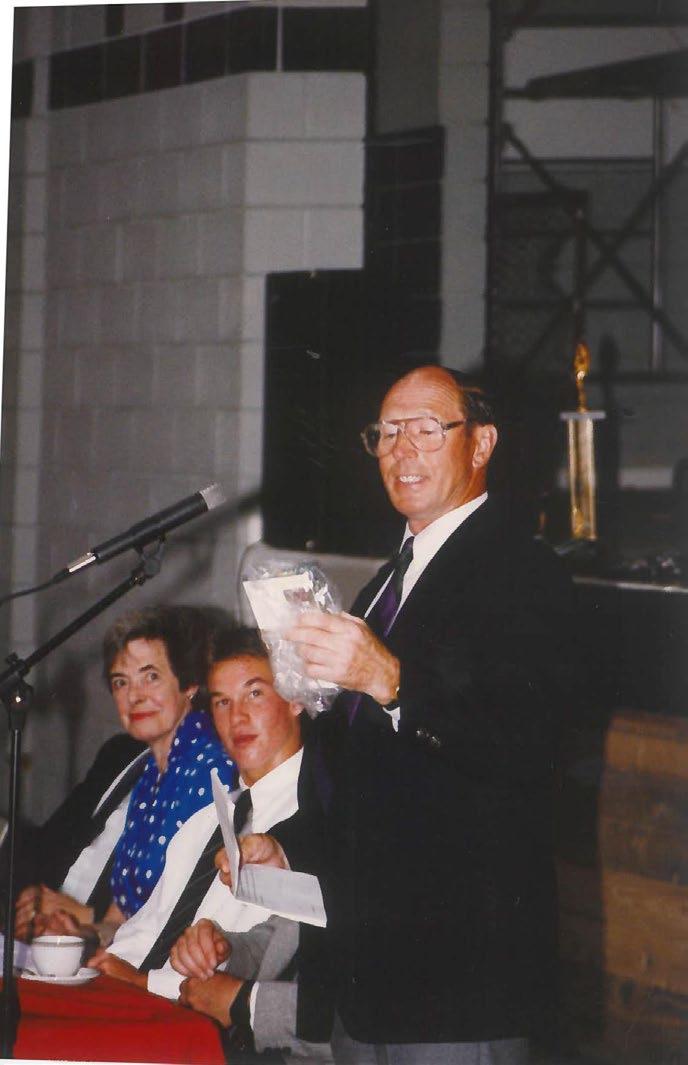


ment, Ray continued to contribute to the school by driving buses for student activities, meticulously marking playing fields, and chaperoning choir and music department trips to Copenhagen, Boston, and New York.
In September 2010, Ray was honoured at a tribute attended by numerous alumni and colleagues. At that time, the gymnasium which was built in 1984 was renamed the Anderson Gymnasium; it was rededicated earlier this year with a newly refurbished floor. The new gym floor was the result of Ray’s philanthropic support for the school; over the years, he had been a generous donor to many campaigns. In 2022, he made a major gift in support of the Wilgress Family Archives and the gym floor project. This year’s occasion was a perfect opportunity to share with our current students Ray’s legacy and his ongoing impact on the school.
Over the years since his retirement, Ray was a regular presence at alumni and campus events. On August 23, 2014, Ray celebrated 60 years of affiliation with Ashbury College, and on that same day, he achieved a hole-in-one and scored an 86 while engaging in his favourite pastime, golf. As recently as this past year, he attended and spoke at the Ashbury Golf Tournament dinner in June and the Old Boys’ Reception in August. He was also seen on the football sidelines and later presented the Alumni Soccer Cup at our Homecoming in September.

The friendships that Ray built at Ashbury have endured a lifetime and include those with Bruce Hillary ’57 and John Rogan ’59, both former students of Ray’s and both of whom were by his side in his final hours. In the words of Bruce Hillary, “I had the good fortune of being at Ashbury just a few months before ‘Andy’ arrived. As his phys ed student and a close friend ever since, I feel he is a man I’ll never forget.”


He showed us all the importance of being fit throughout our lives. He never gave up his steadfast dedication to our school, continuing to work for it even after retirement, keeping our students safe and our fields in magnificent shape.
His quiet demeanor made asking his advice on any subject extremely rewarding. Ninety-five years of living, including those spent with his wife, Eve, and daughter, Susan—he showed all of us what a great life can be had when it’s lived right. R.I.P. Andy!”
John Rogan shared similar sentiments. “Ray was a longtime friend, starting as my phys ed teacher in 1957 (I was not his best student). Our friendship continued through alumni golf tournaments in the 1970s and as poker pals during the same decade. For the last 25 years, one of our friends affectionately referred to me as Ray’s ‘Golf Husband.’
Ray was always a gentleman and fun to be around. You could rely on him and probably expect a little lesson in anything we were doing. He was a true friend.”
Ray Anderson’s contributions to Ashbury College are immeasurable. His dedication to physical education and coaching shaped the lives of generations of students, instilling in them the values of hard work, perseverance, and integrity. As we say goodbye, we celebrate his legacy and remember a man who was not just a teacher and coach, but a true pillar of the Ashbury College community.
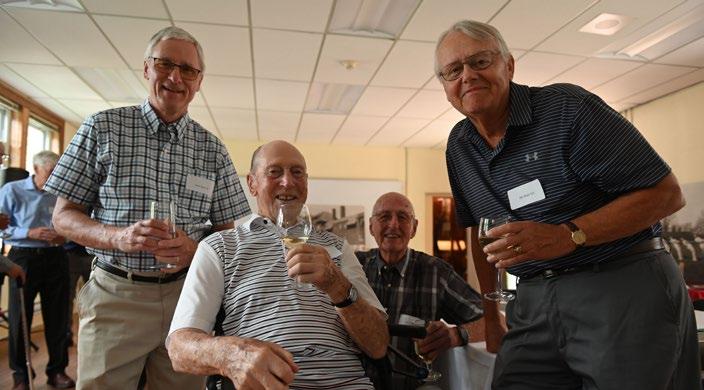

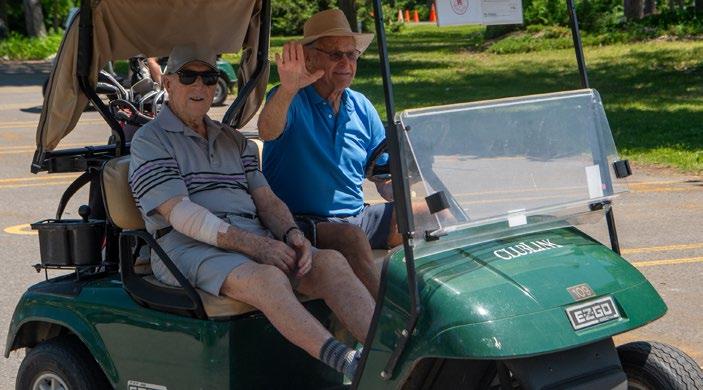
I first encountered Mr. Anderson as an 11-year-old “new boy” at Ashbury in September 1975. For those who were in Mrs. Babbitt’s math class—yes, that was 50 years ago! At the time, he struck me as a supremely fit and stern, “older” man who worked in the senior school. I wasn’t sure how long I’d be staying at Ashbury, but if I did, I certainly hoped I wouldn’t have him as a teacher.
As fate would have it, several years later, Mr. Anderson did become my teacher in the Senior School. And he became my soccer coach for several years. He was also the head of Athletics, or Physical Education—I didn’t know the difference at the time. He also had an evident passion for gymnastics and certainly looked the part. With his barrel chest and solid forearms, he could hold the “iron cross,” perform a “muscle up,” and execute perfect “pike and straddle” positions with effortless ease. Pretty impressive—for a “senior citizen.” But to me, he seemed better suited as a sergeant major for military recruits than a high school teacher.
That said, I had to admit—he commanded respect. After his impressive display on the rings, he often followed it up with Olympic-like vaults off a small, antiquated springboard over a stationary, elevated wooden pommel horse, seemingly built in the 1940s. Bravo, Mr. Anderson—again. But at the time, I couldn’t help but wonder: How was this going to help prepare me and my classmates for the real world? What are we learning here?
I didn’t just stay at Ashbury as a student—I ended up working there for over a decade. And I loved it. By then, “Mr. Anderson” had become “Ray”. I came to learn he was much more than a tough gym teacher. He was honest, disciplined, and unwavering in his values. He knew what he knew well, and he kept life simple. Over the years, he
held many roles—Head of Physical Education (confirmed!), boarding housemaster of Woollcombe House, and later, in retirement, a school bus driver. He was respected by generations of students. He was a demanding coach and a firm but fair boarding master. He didn’t hand out easy praise, and he expected effort and commitment. But beneath it all, I discovered a good man—a really good man.
Eventually, Ray became a friend. And “Ray” then turned into “Andy.” And, over time, I came to realize just how steadfast he was in his priorities. He valued hard work, discipline, fairness, and integrity—not just in athletics, but in all aspects of life. And that, in itself, was a huge lesson for me and his students.
Our shared love of golf brought us closer together, and through those countless rounds, I saw more of the man behind the reputation. He was firm but fair, no-nonsense but kind. His example said it all. He loved his family, Ashbury, his friends, and golf. Of course, I’m sure he loved many other things, but these four were at his core. (Well, five, if you count his love for key lime pie from Denny’s).
One other thing always stood out to me: while I kept getting older and looking older, Andy never seemed to age. If anything, he looked younger. I remain convinced he had a pommel horse and a set of rings hanging from his basement ceiling to keep him in shape!
Mr. Anderson. Ray. Andy. You had a profound impact on my life and the lives of hundreds of students around the world. I will miss you. We will miss you.
God bless.
Stuart Grainger ’83 Head of Trinity College School

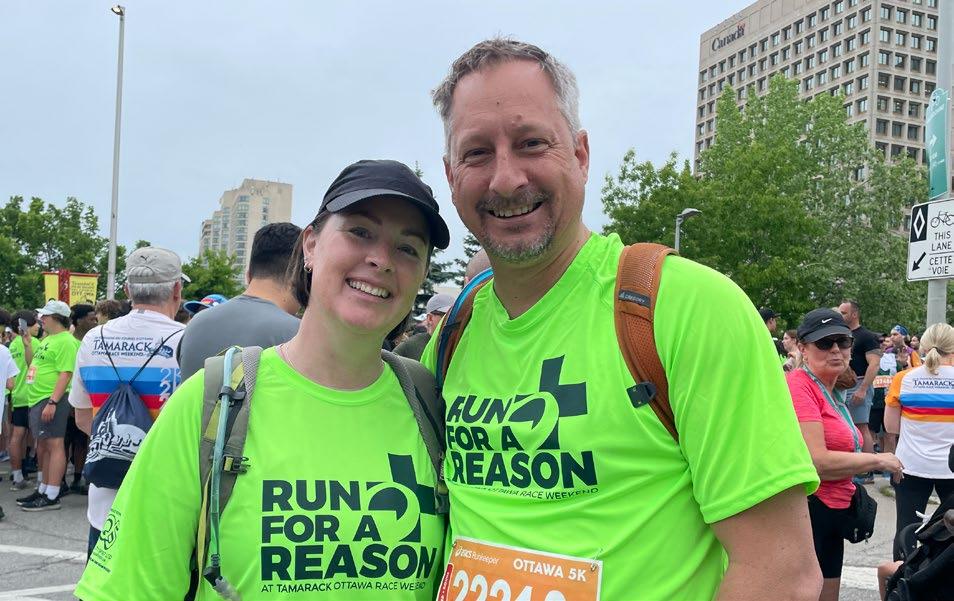

Since 1997, Ashbury has participated in the Tamarack Ottawa Race Weekend in support of cancer research and patient care at The Ottawa Hospital. This initiative evolved over the years, starting with the track team and gradually including more students and staff. In 2004, involvement became the physical education year-end summative, which saw every student in physical education participating in the run. The Junior School has also joined the excitement. Team Ashbury has grown to include more than 450 students, staff, parents, and family members, and in addition to the registered participants, Ashbury students annually staff a water station along the marathon route.
In true Ashbury athletic spirit, we have had several stellar performances at Race Weekend from past and present students, including James ’03 and Jack MacMillan ’16; the Graham family—Ross ’15, Scott ’17, and Hugh ’18; Tyler ’19 and Luke Allan ’21; Kate ’25 and Nicholas Johnston-Zemek ’25; and Maasa Izumikawa ’25. Speed seems to run in families at Ashbury!
The impact of Team Ashbury’s involvement has been fundraising, fast approaching the half-million-dollar mark. None of this would have happened without the efforts of Ashbury’s very own Michelle Holman and her connection with The Ottawa Hospital Foundation.
Earlier this year, The Ottawa Hospital Foundation published the following article to highlight Michelle’s commitment to the cause and the contribution of Team Ashbury. They have graciously permitted Ashbury News to reprint it and share it with the Ashbury community.
Michelle Holman is entering her final year teaching at Ashbury College before retirement, leaving behind a


legacy that extends far beyond the classroom—motivating students to stay active, embrace the power of giving, and passionately support the one institution that touches so many of us: The Ottawa Hospital.
Michelle joined Ashbury College in 1995 as a physical education (PE) teacher and boarding supervisor for students who live on campus during the academic year. In a pivotal moment shortly into her tenure, she was approached by Head of School, Roy Napier, and Dr. Chris Carruthers, an Ashbury board member and former chief of staff at The Ottawa Hospital and asked to create a team at Tamarack Ottawa Race Weekend—an initiative that would connect the school with the community and promote a culture of wellness.
That’s how Team Ashbury was born. “It started with just the track team. Then after a few years, we included staff and anybody else who wanted to join. And then, it soon became so popular.”
Being a part of Team Ashbury at race weekend is now fully integrated into the educational program, spearheaded by Michelle and her department, which consists of eleven
dedicated members of the physical education department, including a head trainer and an athletic therapist. “The most important thing for our students to do is get involved on a school team so they feel part of the community and they have that sense of belonging. It’s like they find their people.”
While encouraging students to stay active was the main driver, Michelle made it clear during their training how important the fundraising was for the community. While fundraising is not mandatory, teaching philanthropy to her students is incredibly important to her and her fellow leaders.
“We’re The Ottawa Hospital’s largest team,” Michelle explains. “We talk about the cancer research, patient care, and how our fundraising will benefit so many in our community. It is a local initiative, but The Ottawa Hospital is on a global scale, and this will be shared with the entire world.”
Every class that raises the most per capita receives a celebratory lunch and treat post-race weekend. Everyone loves an incentive!
Although students are celebrated for their philanthropic achievements, Michelle stresses that their race times are not graded, despite being part of the physical education program. The focus is on their goal setting, training log, and attitude toward working together to achieve a common goal.
“We have walkers, walk/runners, slower runners, faster runners, and it’s important for everyone to be celebrated. That’s what race weekend is all about.”
Michelle and her department’s commitment to their students and community is truly inspiring. As many educators can attest, extracurricular activities often require time outside of school hours. Team Ashbury trains for 10 weeks leading up to race weekend, culminating in a two-day event with over 450 students, families, and teachers—a remarkable undertaking alongside their full-time teaching roles.




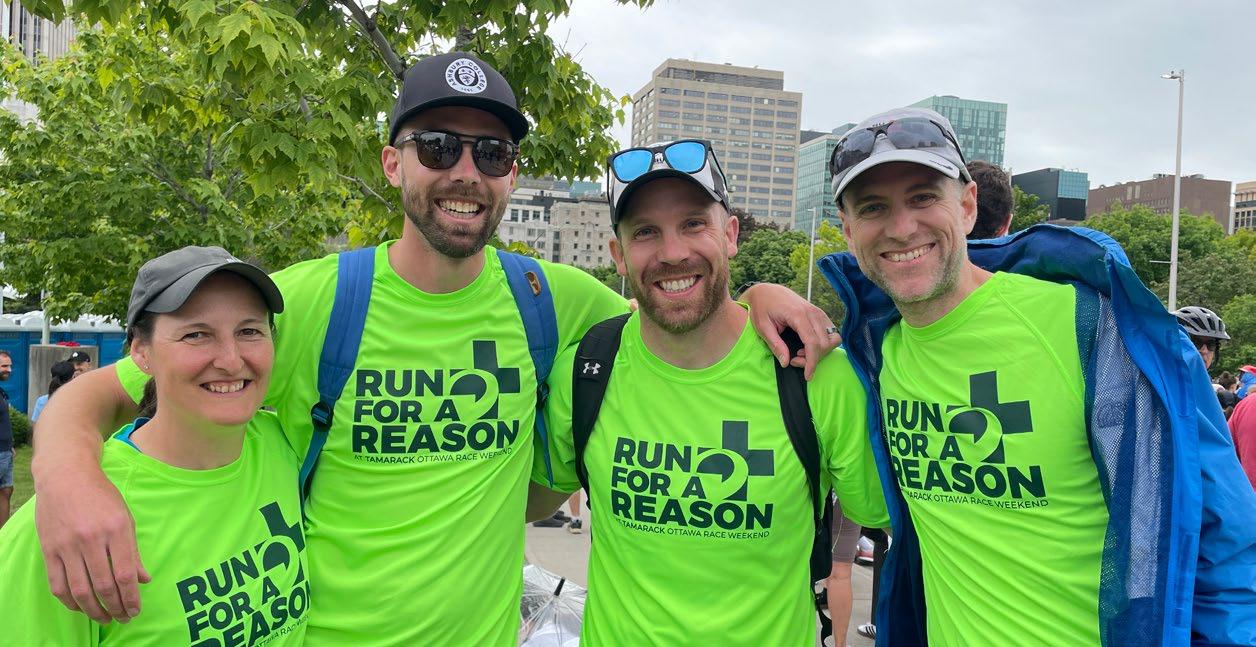
Michelle’s personal connection to cancer care runs deep, shaped by heartbreaking loss. At just 57, her father— vibrant and full of life—died from stomach cancer, marking Michelle’s first encounter with the vital importance of compassionate, skilled healthcare. Her father, the man who introduced her to running, also unknowingly sparked her lifelong dedication to supporting cancer research and staying active in the fight against this devastating disease.
“He was really young, and nobody could believe it because he was always so healthy. The timing was close to when I started at Ashbury, so I thought: for sure, get involved in fundraising for The Ottawa Hospital.”
When Michelle’s mother was 81, she was diagnosed with breast cancer. She received treatment at The Ottawa Hospital. Now, at 84, Michelle’s mother is doing remarkably well and was able to spend the summer of 2024 on the golf course. Michelle credits her mother’s strength and good health to the exceptional care she received at our hospital, calling her “stronger than ever.”
Tragically, Michelle’s close friend passed away from breast cancer at just 42 years old. Though her friend didn’t survive, Michelle is grateful for the exceptional care she received at The Ottawa Hospital.
“This is why I’m pretty passionate about sticking with The Ottawa Hospital because the Cancer Center is amazing,” adds Michelle “We’re so fortunate. As we sat in the hospital during our visits, we heard about people coming from all over the region for care.”
Michelle deeply understands the life-changing impact of having world-class care right here in our city, supporting not just our region, but people far beyond. Though she never imagined cancer would touch her so personally, it has opened her eyes to the overwhelming importance of community support, ensuring that the care we all need is there when we need it.
“Everybody’s going to probably be touched by cancer in some way, shape or form. With someone they know, or someone in their family. It just makes sense for us to support.”
“ ”We have walkers, walk/runners, slower runners, faster runners, and it’s important for everyone to be celebrated.
The most common question for those nearing retirement is, ‘What’s next?’ Michelle knows her future is filled with endless possibilities, and she’s certain it will involve staying active— both with her local track teams and in fundraising efforts.
Her bonds with her students and the PE department are far from over; they remain deeply cherished and will be some of her most treasured memories.
“The kids and teachers are amazing—they really are. They get so excited. They buy in and were all part of it. My entire department supports this team and without them I wouldn’t be able to do it.”
Michelle envisions other local schools embracing the race weekend, which she calls the best event in our city and
a crucial fundraiser for The Ottawa Hospital. Through her dedication, she has sparked an incredible movement that brings students, families, teachers, and faculty together to be part of something truly monumental.
When reflecting on the future of Team Ashbury, Michelle feels nothing but excitement for what lies ahead. “I am confident that the unwavering support from the entire Ashbury physical education department will allow us to maintain a strong presence at the event and reach new heights.”
As she moves into her next chapter, Michelle hopes others will continue to carry the torch, inspiring future generations to stay active, give back, and make a lasting impact. This is more than just a race; it’s a legacy of community, compassion, and change.

On May 24, Team Ashbury proudly hit the streets of Ottawa in a powerful show of support for The Ottawa Hospital. Undeterred by the cool and cloudy skies, our spirited students and staff brought energy, heart, and determination to the race. Their enthusiasm was matched only by the incredible generosity of our community—together, we raised nearly $19,000 in support of life-saving cancer research and care.
Passionate Graduates Strengthening Global Alumni Connections
Ashbury’s Alumni Executive is a dedicated team of volunteer graduates working to build a vibrant and connected alumni network. Their mission is to strengthen ties among alumni, keep the community informed about developments at Ashbury College, and organize events and initiatives that encourage lasting engagement with the school. Meet the members of this dynamic team below.

Senior Advisor, Employment and Social Development Canada
What do you enjoy most about your role as President?
One of the most rewarding parts is the opportunity to support the school in creating events and initiatives that bring the Ashbury community together. I truly value the chance to connect with fellow alumni and foster meaningful relationships. It’s incredibly fulfilling to watch these connections grow through events like Homecoming, various school initiatives, and networking receptions around the world. Even through Ashbury Connect and Ashbury News, we get to follow the journeys of alumni—their career achievements, life milestones, and everything in between. These connection points, where we come together as a community and celebrate our shared experiences, are what make it all so special.
Software Engineer, Bank of America
Do you have a favourite memory from your time as an Ashbury student?
My favourite memory from my time at Ashbury was the Huntsman Marine Institute field trip to New Brunswick. As a member of Mr. Oates’ Higher Level IB Biology class, I joined a week-long trip out to the Bay of Fundy to get hands-on experiences in the ecological sciences. This trip provided me with an excellent idea of what ecological field work looks like, as well as allowed me to explore a beautiful part of Canada with some of my closest friends and amazing teachers.

Account
Manager,
Premium and Group Sales, Ottawa Senators Hockey Club
What made you get involved with the Alumni Executive?
After spending nine formative years at Ashbury and finishing as a “lifer,” I felt a strong desire to stay connected to the community that played such a significant role in shaping who I am today. Ashbury helped instill in me a solid work ethic, a sense of leadership, and a deep appreciation for community. I’m proud to be an Ashbury alumnus, and I believe maintaining ties with fellow alumni is not only meaningful but essential to enhancing the amazing culture of the school.

Past-President Owner, Prism Property Services
What do you enjoy most about your role on the Alumni Executive? What I enjoy most is staying connected to the Ashbury community and helping foster a strong sense of belonging among alumni. It’s fulfilling to support events and initiatives that bring people together and celebrate our shared experiences. I value the opportunity to collaborate with fellow alumni who share my passion for giving back. Being part of the Executive allows me to contribute meaningfully to a school that continues to shape lives long after graduation.

Principal, Boyden
What made you get involved with the Alumni Executive?
I wanted the opportunity to give back to a place that played such a formative role in my personal and professional journey. Ashbury College provided a launching pad for who I am today, and joining the Alumni Executive felt like a meaningful way to contribute to the community that shaped me. I’m passionate about enhancing engagement between alumni and current students to foster collaboration, mentorship, and growth. By helping to build connections across generations of Ashburians, I hope to support the development of the next generation of leaders—people who will, in turn, give back and make their communities better.
Realtor, Royal Lepage
Performance Marland
Realty
How do you think Ashbury helped you get where you are?


Ashbury instilled in me the values of honesty, courage, and kindness, teaching me to be a fearless advocate for myself and others, and not to be afraid to stand up for my principles, even if it sometimes means standing alone. From entering Ashbury in Grade 9, having only ever been homeschooled, to being elected as Athletics Prefect in Grade 12, I will forever be grateful for the environment of excellence at Ashbury and the incredible support of my parents that has allowed me to become who I am today.

Broker, Re/Max Hallmark Realty Group
What made you get involved with the Alumni Executive?
It truly begins with a deep-seated appreciation for the school. Since graduating in 2003, I have consistently sought to maintain a close connection with Ashbury staff and students. Whether it was continuously networking with fellow proud alumni members or enjoying the weekly basketball games on Friday night, being an active member of this community has always been a priority for me. A few years ago, I made it my mission to get involved with various organizations looking to make a difference and joined the Alumni Executive. It was a no-brainer.
C A M P U S H
















Ashbury News asked our new Head of Junior School, Mr. Andy Young, to share his thoughts on leadership and learning.
When I first applied to work at Ashbury, I spoke with colleagues in the CAIS network about the school and asked what the Junior School was like. Many of them described it as the heart of the school. While I acknowledge that I am biased, these words remain true a decade later.
It was with great excitement and gratitude that I stepped into the role of Head of Junior School at Ashbury College. Since joining the school in 2015 as Assistant Head of Junior School, and most recently serving as Interim Head while Kendal Young was on sabbatical, I have had the privilege of working closely with our incredible students, staff, and families. Ashbury’s commitment to excellence in education, character development, and community has always been a critical component of the Junior School, and I am eager to continue building on that strong foundation.

Every morning, rain or shine, I shake hands with each student as they enter the school. Fridays don’t begin with a handshake but instead a high-five. Most of these interactions end with a laugh and a smile, starting each student’s day on a positive note. This helps every student feel safe at school. When children know they are supported by caring educators and a welcoming community, they develop the confidence to explore, create, and grow. Our goal is to nurture curious, resilient, and compassionate young learners who will carry these qualities with them into the future.
At Ashbury, we recognize that a child’s elementary years lay the groundwork for a lifelong love of learning. My leadership is rooted in a three-dimensional approach to education, one that focuses on
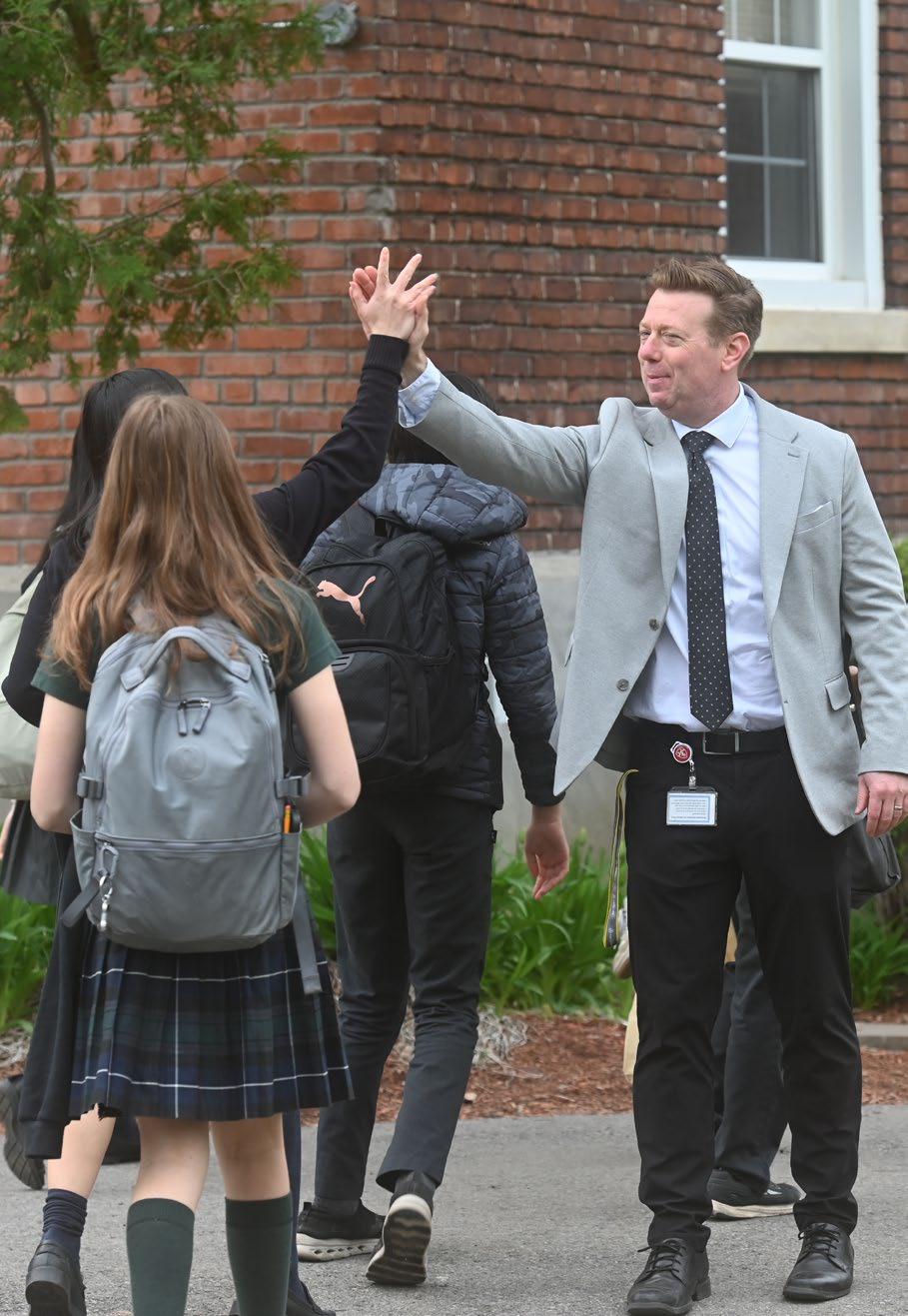
understanding each child as a whole person. Academic achievement is important, but so too are socialemotional growth, personal strengths, and individual learning styles. Strong relationships are central to this philosophy: when students feel seen, heard, and valued, they are more engaged, confident, and willing to take risks in their learning. Of course, all of our work is centred around our motto of Honesty, Courage, and Kindness, or as we refer to it in the Junior School, HCK.
I am excited about the journey ahead and look forward to working together with students, staff, and families to make our Junior School a place of inspiration, belonging, and success, as we continue to be the heart of Ashbury.
We are confident that under his leadership, the Junior School will continue to be the heart of Ashbury, inspiring future generations.
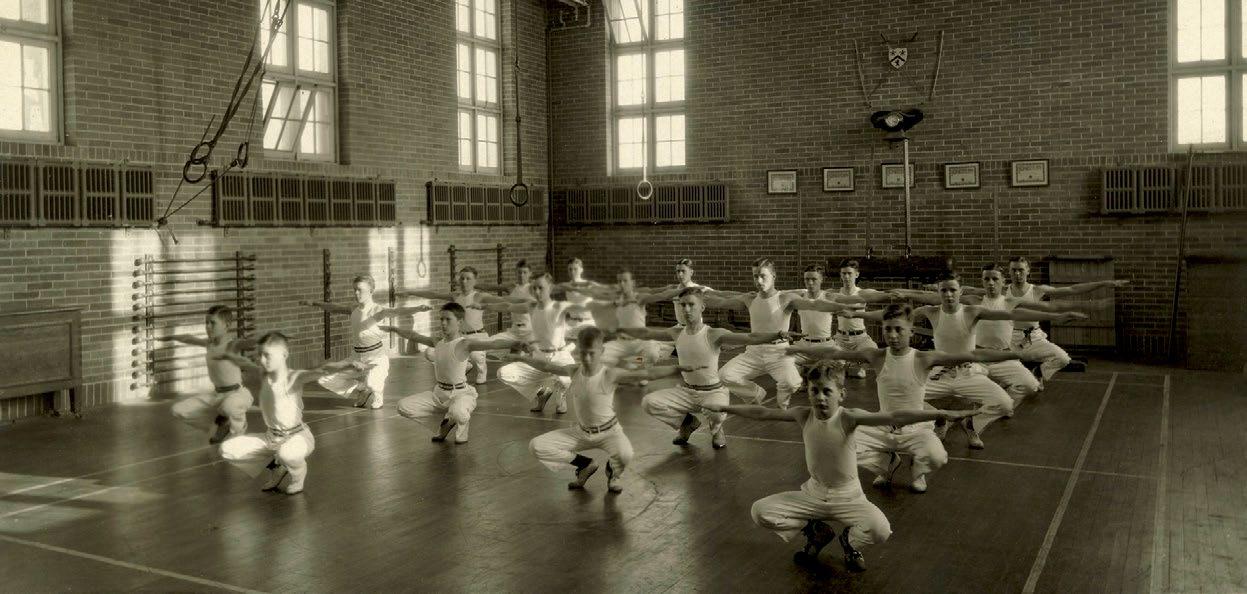

Nestled at the heart of Ashbury College, the Memorial Gym stands as more than just a building, it is a living testament to the bravery and sacrifices of alumni and staff who gave their lives in service. For over a century, this beloved space has been a cornerstone of the Ashbury experience, echoing with the memories of generations. And now, it’s time to safeguard its legacy for the future.
Picture the Memorial Gym in its prime: the energy of basketball games, the chatter and creativity of the “Artnasium,” the quiet concentration during exams, and the shared anticipation before assemblies. These walls have witnessed the moments that shaped countless Ashbury stories, moments of triumph, camaraderie, and growth. The gym has always been more than just a place; it has been a vibrant gathering spot, connecting the Ashbury community. Yet, while its history is rich, the infrastructure of the Memorial Gym has aged. What once served as a gymnasium, library, and central hub now struggles to meet the demands of today’s students. To honour its heritage while supporting the dynamic needs of future generations, Ashbury College is embarking on a visionary project to restore and revitalize this cherished space.
This restoration is not just about preserving a physical space; it’s about safeguarding the spirit of Ashbury College. It’s about honouring the legacy of those who came before us while paving the way for future students to create their own memories.
The Memorial Gym’s transformation is designed to preserve its historic character while introducing modern, state-of-the-art enhancements to elevate its functionality and inclusivity. Here’s a glimpse of what’s to come:
• Enhanced Acoustics: A newly designed ceiling with advanced acoustic panels will create a versatile soundscape, perfect for everything from lively performances to quiet reflections.
• Flexible Seating: Innovative, fold-away seating will maximize the gym’s adaptability, enabling seamless transitions between activities.
• Restored Windows: Updated windows will bring energy efficiency and abundant natural light while restoring the gym’s architectural charm.
• Dynamic Lighting: Cutting-edge, adaptable lighting will set the stage for any event, be it a guest speaker, a full grade meeting, athletics, dramatic arts performances, or wellness sessions.
• Improved Accessibility: A thoughtfully extended ramp from the Glenwood entrance will provide wheelchair access directly into the gym and beyond into the Teron Foyer, ensuring inclusivity for all.
Your support can make this vision a reality. Together, let’s ensure that the Memorial Gym continues to inspire, unite, and serve as a lasting tribute to Ashbury’s history and future. Join us in preserving this iconic cornerstone of our community.
For more information, please contact Stephanie Young, Director of Development, stephanie.young@ashbury.ca



PRESENTING SPONSORS
Sezlik.com

Ashbury College rolled out the red carpet for a spectacular Hollywoodthemed Ashbury Ball, bringing together the entire Ashbury community, including parents, alumni, staff, and friends for its signature fundraiser. Guests stepped into the spotlight, passing a dazzling Walk of Fame and entering through an elaborate archway before indulging in a gourmet dinner in the beautifully transformed Benloulou Gymnasium.
Head of School, Norman Southward, underscored the heart of the evening, noting, “Our students are at the front and centre of everything we do.” The event’s proceeds support need-based student financial assistance, environmental stewardship initiatives, and the development of a cutting-edge digital production studio. A special thank you to our hard-working Ball Committee for an outstanding event.
The evening was made possible thanks to ‘Presenting’ sponsors Sezlik.com, Star Motors and Mercedes-Benz Ottawa Downtown, our ‘Executive Producer’ sponsor Hickman Specialist Group, our ‘Director’ sponsors Richcraft Homes and WCPD Foundation, and our ‘Director of Photography’ sponsor ExecHealth. Their generous contributions helped create an unforgettable night of celebration and philanthropy.
Star Motors & Mercedes-Benz Ottawa Downtown
EXECUTIVE PRODUCER SPONSOR
Hickman Specialist Group
DIRECTOR SPONSORS
Richcraft Homes
WCPD Foundation
DIRECTOR OF PHOTOGRAPHY SPONSOR
ExecHealth


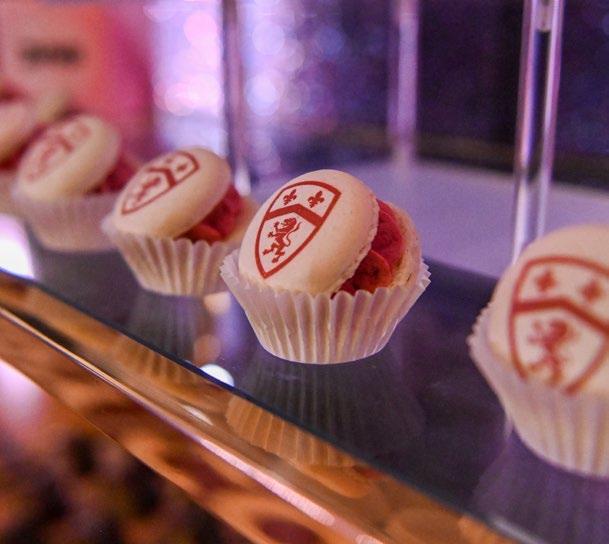





Through the generous support of an anonymous Ashbury family, the BGCO (formerly the Boys & Girls Club of Ottawa) Bursary is now available to a student, with preference given to a student entering Grade 9, who is a current member of BGCO and has demonstrated financial need. Prospective students are identified in collaboration with the BGCO. This is a story of a COVID silver lining, as we share how one family is now changing the lives of students for years to come, and a call to action to contribute, as we pass along an act of kindness we’ve received, to touch the lives of local youth.
In the first summer of COVID-19 closures, this family, like many in the Ashbury community, grappled with how best to educate their children as we all weathered the uncertainty of the COVID-19 pandemic. With family in the Ottawa area, they reached out to Ashbury on a Monday, applied on Tuesday, conducted interviews on Thursday, and tested on Saturday. The following Tuesday, they received an offer to enroll both kids in the school. And so, the story begins. Their oldest child graduated last year, and their second is currently in Senior School.
Within 10 days, the family decided to move to Canada for one year.
“At first, the kids hated it, until the end of the year when they decided they loved it! The kids said, “We didn’t want to come, but now that we’re here, we aren’t going back. You figure this out!”
“Do your little bit of good where you are; it’s those little bits of good put together that overwhelm this world.”
When the school resumed cocurricular activities, their son started playing basketball, and Mr. X began assisting Coach MacKinnon with practices and “hanging out with the basketball guys”. He discovered a strong relationship between the BGCO and Ashbury, as Coach MacKinnon was already facilitating relationships and helping students access need-based financial assistance. As a self-proclaimed “start-up guy,” Mr. X began brainstorming with Coach MacKinnon to determine how they could roll out something more structured. The family made an initial donation to seed early initiatives that supported young people from the BGCO who demonstrate a combination of athletic and academic excellence.
Athletics and the inclusion of diverse perspectives are important to

the family. A bursary that supports both athletics and academics was a perfect fit for them. Ashbury’s Director of Development, Stephanie Young, reached out to discuss how they could more formally establish this new initiative.
“This is a way to say thank you in a countable form to a place that had an impact on our family in a moment of crisis. We are modelling traits that we want our kids to emulate, helping people around them. This becomes a really easy reason to get involved— seeing what it has done for our kids and wanting to see that extend to as many others as Ashbury can serve. It is also a tangible way to say that we are investing in our community. It is a matter of when we can help, and if we have the means to do it, we should. When you are part of this community, the question is how to support the organization’s mission, to expand its reach, and enable it to support more children and establish a firmer foundation for the long term.
In the words of Desmond Tutu, “Do your little bit of good where you are; it’s those little bits of good put together that overwhelm this world.”
Supporting the BGCO Bursary is more than providing need-based financial aid; it’s a bridge to opportunity for amazing and talented young people.
If this family’s story inspires you, we invite you to contact Stephanie Young, Director of Development, at stephanie.young@ashbury.ca

Ray Anderson
Robert Elliott
Geoffrey Morson
H. Scott Price
Andrew Somers
Dr. Matthew Suh
JoAnn Valiquette
Doug Wadsworth
Past Staff
Parent of Jonas ’97 and Andrew ’01
Alumnus ʼ61
Alumnus ʼ50
Alumnus ʼ81
Parent of Stephen ’79 and Daniel ’97
Parent of Michael ’92 and Benjamin ’93
Parent of Amy ’98
After planning for those you love, you may f ind deep fulf illment in shaping a lasting legacy one that supports future generations of Ashburians for years to come
If you are interested in learning more about Ashbury’s Legacy Society and planned giving:
Please contact Stephanie Young at stephanie.young@ashbury.ca


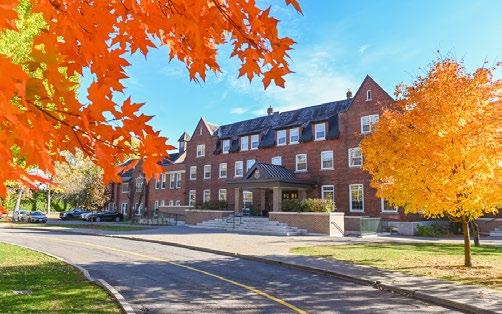





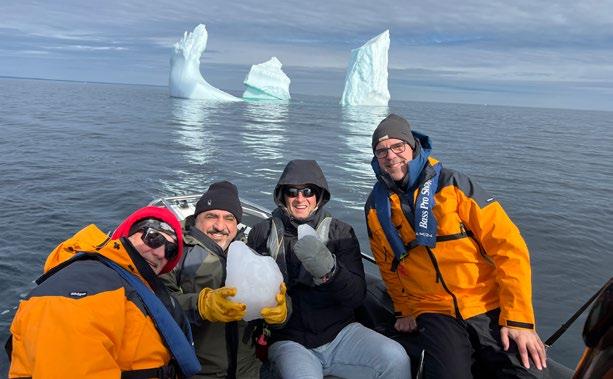
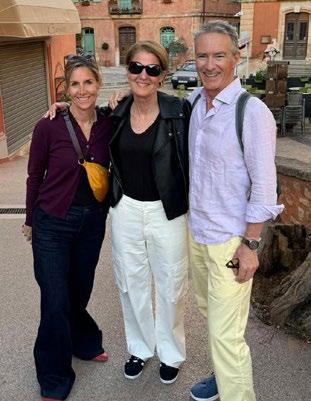



Chris Teron ’76 was awarded the King Charles III Coronation Medal for community service (volunteering) in recognition of 25 years of service at the Canadian Ski Marathon, Ashbury College, the Royal Astronomical Society of Canada and other organizations.
Jeff Mierins ’82 and friends Mehrdad Azadeh ’81 , Kaveh Rikhtegar ’82 , and Kevin Keenan ’82 were spending some time together off the coast of Salvage, NL.
Brett Naisby ’83 has been living summer to summer in Tuscany and New Zealand since 1994. For the last 30 years, he has been running his company, Customwalks, which offers hiking and Vespa tours in Europe. Besides Tina ’83 and Tricia Reilly ’91 (see photo), who joined Brett on a Provence hiking tour this May, he also reconnected with Mo Abhari ’83 when he and his wife did a hiking tour in Tuscany.
Andrew Inderwick ’84 (eXp Realty) and Neel Chadha ’06 (Kemptville Lifestyles) were promoting their new business venture, Kemptville Lifestyles, which will bring luxury apartments to the community, when Ashbury Ambassador, Brian Storosko, spotted them. The project broke ground in the spring of 2025.
Stewart Johnston ’90 was named the 15th Commissioner of the Canadian Football League. Stewart has served as the president of The Sports Network since 2010. He assumed his new role in April.
Andrew Pepper ’92 has been a busy fellow! He married his longtime girlfriend, Olena Oblitsova, in 2021, and they had twin daughters, Alina and Avrora, in 2022. Professionally, he works in films, TV, concerts, and on stage, handling camera dolly, crane, and rigging. Recent projects have included Avatar: The Last Airbender, Shogun, Percy Jackson and The Olympians, Coldplay, Guns N Roses, Taylor Swift, and AC/DC.





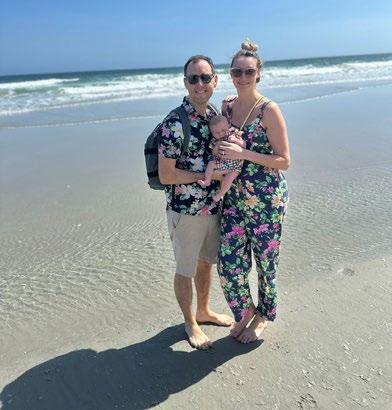

Dharini Woollcombe ’93 portrayed the central character in the recent production of The Roof is Leaking ਛੱਤਚੋਂਦੀਹ , which is described by the playwrights as “a love letter to South Asian mothers,” exploring the quiet endurance and unspoken sacrifices of Punjabi/South Asian women who hold their families together. The characters in the story grapple with duty, love, the weight of tradition, and what it means to truly see your family.
Jimmy Yang ’97 , Managing Director and Canadian Health Practice lead at Accenture, conducted a health care survey of over a thousand Canadians nationwide. The survey assessed people’s opinions on what they want and are ready for from the healthcare system. Results indicate that people want a system and an experience that is personalized, more efficient, and more convenient.
James Kenny ’02 has launched two new businesses— Prism Property Services, Ottawa’s premier home cleaning and maintenance service, and Grill Hero Ottawa, a professional BBQ cleaning and repair service operating in the National Capital Region.
Emily Shore ’03 and husband Adam Gold, welcomed baby Devon Bella into their family on August 13, 2024, making big sister Zoe the happiest girl ever. Devon’s Hebrew name— Ora Yaffa—translates to “a beautiful light.” It is perfectly spot on.
Tyler Wilgress ’03 and his wife, Lauren, are thrilled to announce the birth of their son, Cameron Davison Wilgress, born on February 26, 2025.
Danya Vered ’04 received the King Charles III Coronation Medal in recognition of community volunteering and leadership, including serving as Chair of the Board of Directors of United Way East Ontario during the pandemic, and as the incoming Chair of the Board of the Jewish Federation of Ottawa.
Annie Claire Bergeron-Oliver ’07 and Connor Duncan are the proud parents of Oliver Duncan, who was born on his due date, September 24, 2024, in Ottawa. They are loving every minute with their big, smiley boy.
Julie Segal ’13 was awarded a King Charles III’s Coronation Medal. The Medal is awarded to people for having made exceptional contributions to Canada. Segal’s award was in recognition of her contributions to the environment and climate action, and to making Canada’s economy and financial system more sustainable.
Michael Cullen ’14 starred in a commercial with Mark Messier for Kith, the New York-based fashion brand. The advertisement can be found online and aired at Madison Square Garden during “Kith Night”. Michael says, “This was probably my one and only opportunity to be on the big screen in life!”
Leah Mousseau ’14 was recently appointed as the Assistant Coach and Sport Development Coordinator for Team Canada’s Women’s Sitting Volleyball National Team. In this dual role, Leah will be supporting high-performance athletes on the path to international success while also leading initiatives to grow and develop sitting volleyball across the country.
Emily Amano ’18 has returned home to join Ottawa Rapid FC for the inaugural season of the Northern Super League. After playing professionally in Sweden and Iceland, Emily is now part of Canada’s first women’s professional soccer league, fulfilling a dream she once thought impossible. She aims to inspire the next generation of players in her hometown, emphasizing the importance of visibility and opportunity in sports.
Lavinia Cyrillo ’18 recently completed a student-teaching rotation at Ashbury. Lavinia says, “The weeks I recently spent at Ashbury helped me solidify my teaching values: a commitment to lifelong learning, the establishment of positive and respectful relationships with students, and a dedication to a strong work ethic. These values are a direct result of my Ashbury teachers’ trust and generosity, which equipped me with confidence and a sense of responsibility towards the students, the community, and the teaching profession.”










Trevor Matthews ’02 produced the critically acclaimed and award-winning film, The Brutalist. The movie received ten nominations at the 97th Academy Awards, including Best Picture, and won in the categories of Best Cinematography, Best Original Score, and Best Actor for Adrien Brody. At the 82nd Golden Globe Awards, it secured three awards, including Best Motion Picture – Drama. The Brutalist was named one of the top ten films of 2024 by the American Film Institute.
Kristi Godkin ’21 has been awarded the Outstanding Women of Laurier Award, which is presented to a student-athlete who best demonstrates athletic success, academic achievement, and commitment to the development of young athletes through community teaching or coaching. Apart from her record-breaking golf season with three individual wins and a bronze at provincials, Kristi was recognized for her volunteer work with First Tee and her job as an athlete academic coach, mentoring the first-year athletes at Laurier.
Luke Allan ’21 claimed first place in the 30 km classic event in the Canadian National Ski Championships in Canmore, Alberta. Luke also finished the week of racing ranked first in the overall aggregate rankings for the senior men’s category.
Christopher Selva ’24 is thrilled to share that his team secured second place at the Queen’s Accounting Association × Queen’s Consulting Association (QCA) Big 4 Case Competition at the Smith School of Business, Queen’s University. Teams were tasked with delivering a comprehensive case analysis that focused on business development, ESG standards, renewable energy solutions, and effective cost allocation. It was an incredible opportunity to learn, grow, apply their skills, and present the final product in front of representatives from KPMG, EY, Deloitte, and PwC.
Simone Gendron (Staff) was recently awarded the Keith Mann/ NAC Orchestra Outstanding Band Director Award as part of the 2025 MusicFest Nationals. This award is given annually to one outstanding concert band director from across Canada.
Didier Périès (Staff) has released his fifth novel, which is an intense work of literary fiction that skillfully weaves together two seemingly disparate worlds: exile and sport. It is the harrowing story of Nana, a young Mauritanian migrant girl, who finds, on the French rugby pitch, a path towards resilience. Through this story, the author gives a voice to those we do not hear enough, and offers us a new perspective on immigration, adolescence, and the force of the collective spirit.
Chris Miedema, Saba Usmani and Tui Noonan (Former Staff) make retirement look really great as they gather in Lisbon, Portugal, on February 20.

Vicky (Victoria) Wilgress (Former Staff) was awarded the King Charles III Coronation Medal for community service (volunteering) in recognition of her many years of volunteer contributions. Her various volunteer activities have included events with the Canadian Cancer Society, Chair of the Education Committee with the United Way Cabinet, a variety of committees as volunteer and committee Chair at the Royal Ottawa Golf Club, volunteer with the Canadian Pacific Women’s Open and the Canadian Women’s Senior Golf Association, Director on the Board for Canadian Guide Dogs for the Blind, and numerous other community-based volunteer activities around Rockcliffe and with Ottawa tourism. Vicky also continues to share her extensive history, knowledge and time with the Ashbury Archives as we continue to rediscover and catalogue gems from the school’s past.
The Fall of 2025 will see some significant changes to the Ashbury staff roster. Announcing their retirements this summer are teachers Michelle Holman, Lisa Lewicki, Alyssa Novick, Derek Taylor, Professional Development and Instructional Advisor, Kendal Young, and Director of Human Resources, Bill Palamar. Our next edition of the Ashbury News will showcase the contributions of these amazing individuals to Ashbury for more than a quarter of a century.







